#in general just assuming all media is drawing from The Most Popular Example Of A Thing
Text
i love the artistic stylings of studio ghibli as much as anyone else does but im kind of sick of anything with like vivid environments and big blue skies being branded as ghibliesque. because its like. you know where else you can hypothetically find some vivid environments with big blue skies? my friend the great and wonderful outdoors are here for you
#in general just assuming all media is drawing from The Most Popular Example Of A Thing#rather than being like hey maybe both these things took inspiration from the same parts of our world#just feels kind of unfair and reductive a lot of the time#not to say its bad when something IS inspired by ghibli but its kind of the professional version of being asked 'wow is that anime'
21K notes
·
View notes
Note
☀ About controversial topics in roleplay. Would you say there are obvious forbidden topics in roleplay or do you think we could go as far as we want considering it's all fiction? Where do you draw the line and is this line a different one from the one in the content we consume (I'm thinking of popular shows and movies with shock values that sometimes play on morally questionable topics yet are fully accepted/watched/enjoyed by the majority).
lynnie is letting me shoot myself in the foot ( ask me anything about rp meme w/ @uroborosymphony )
send a ☀ along with a roleplay related topic to hear my thoughts on it. Ask me anything!
LYNNIE!! First of all, excellent question, it’s one i’ve thought a fair bit about recently and while it looks straightforward, I’ve found?? It can be a lot more complicated than that, so thank you for enabling me and my rambling here-
So let me just start with saying that I’m not going to police people for what they write because if i did, i’d be miserable and i’d have no energy to focus on my own writing. If i see someone writing content that makes ME uncomfortable or upset, i leave or block, it’s not that hard. just tag your posts or let people know in your rules that you don’t tag triggers and you’ll be fine.
Okay, now with that out of the way, i think when it comes to this conversation, the worst takes on this always come from individuals who fail to like…moderate their beliefs ( for example, yes this is all for fun so you should respond to things when you feel the most inspired, but if it’s to the point that you start threads and post memes that you NEVER reply to…well makes sense if people end up dropping you ngl :/ ) like yeah writing just happy and nonharmful things would be rather dull, but also when writing something that contains sensitive content, we need to be respectful because there are people in rl that are affected by this. Fiction may not be real, but reality informs the writer and therefore the fiction written which when consumed will affect reality in turn. That being said, i assume that people who write the say, more controversial topics know that it’s fiction and it should not be practiced in real life….that’s one of the things i feel like people forget? We’re not mindless sheep who agree with and take everything we watch as actual reality.
That being said, for me whether line differs between roleplay and forms of media like say, books and tv shows really comes down to intent. what is a reason for a controversial scene to be written- is there a point to be made, an intention behind it? if written with care and thought, books and tv shows can do it, but with roleplay unfortunately a lot of times what is written is usually purely for enjoyment? Not that a story or an intention can’t be attached to a roleplay, but since roleplayer they usually write for themselves, i assume that both parties enjoy what they’re exploring and writing….so when i see someone writing say, noIn-con for example, i can’t help but give the side eye: the difference between seeing this kind of scene in prose and in a roleplay is that if it is done well in prose, there is usually an intention behind it and the characters are developed beyond that event; the same can’t always be said in a roleplay.
I will say though, regardless of the medium, it is perfectly possible to explore dark content in a respectful manner. When you write these topics, you can portray it without coming off as voyeuristic or trauma porn. For example, with say something like s*exu*al a*ss*ault, going into explicit detail is not necessary to explore the repercussions of such an event. ( of course media in general does not do a good job of this but that’s besides the point :/ ) But whereas in prose, a writer can gloss over the event, the problem in an rp thread is that you’re supposed to immerse yourself in your character’s head/environment…and some roleplayers do so for this kind of content in the name ‘character exploration’....which full offense, i don’t buy that.
The other hard line i also will always draw is always with historical muses, specifically wwii muses or muses that commit crimes again humanity. Rp is a practice in empathy and so to see someone humanize individuals that have committed major war crimes and human atrocities makes me kinda pissed bc it might just be history to the writer, but for a lot of people, that history still affects them and their families to this day.
#( about ferre. )#that would be truly wonderful ( ooc. )#uroborosymphony#lynnie!! thank you for this question- i hope?? i was able to answer this reasonably enough#or that it was at least coherent#there was a lot that i felt like needed to be extra explained#but also....common sense i personally just go by#basically tldr; yes there is a line but it's flexible in that#it really comes down to how it's portrayed and what the intent is supposed to be
2 notes
·
View notes
Note
Writing Inquiry: When you write like anime characters, take Bakugou for instance (particular because he defies most basic norms) do you ever consider Japanese customs? (/gen) I’m asking cause I’ve been writing and I keep questioning where to draw the line. Also what to do about language and social barriers or do I just act like they don’t exist? I know there’s no right thing, but you are one of the best writers I’ve seen and I admire you a lot so I value your opinion. Would you read something that focuses on nuances like that? Or do people not care for them in fiction? Should I care? Anime is hard idk.
i don't mind answering this but im not sure if it's a good answer. idk how to explain it well but in general.. i think it's important to consider to what level you are understanding of those japanese customs and cultures
one of my best friends / exes growing up was japanese but im also an asian person. asian cultures tend to have a lot overlap. the thing i generally want to implore people to understand is like.. what is the reason for the implementation of cultural standards in their fic. not really about what they should or shouldn't do but like.. if they understand at base level what it means.
a good example here is honorfics.
it's notable in anime. words like senpai or kouhai, the addition of -kun or -san. i think it's mostly up to you whether or not you need to use those words, but it's more important that you understand that these words have cultural weight and context. the use of honorifics speaks to a much larger idea in Japanese culture about respect for your seniors. honorifics are not just... words. they're indications and essentially marks of someone's position in regards to someone else. and there are other ways aside from language to demonstrate that respect, like bowing your head to someone or letting someone speak first
in that same sense, i think people really.. misconstrue the use of these words even in the sense of japanese media. the word senpai has sort of lost it's meaning among a lot of western fans and has been bastardized to an almost alarming degree but that word is a word with cultural roots. it highlights element of culture and respect, and if you're going to write something in - are you able to grasp that level of nuance?
if you're reading a shoujo manga with a female lead who calls her crush senpai - her usage of this word at the baseline is a bare minimum respect for this person. additionally the instances in which she calls him that, when she's able to drop that honorific etc. these are all like.. real life concepts and ideas. that build-up to familiarity. they have significant root in the japanese culture.
most anime characters are in a japanese universe and are japanese, so i understand the troubles. i do indeed consider japanese customs, probably more frequently than most writers because i myself am asian and recognize these beliefs more broadly. i think it's important to remember it's not really a one to one scenario, but to understand more fundamental ideas about the culture and imply those.
instead of knowing when to use -kun or -san or -sama - does your character give their seats up to elderly people? how do they go against their cultural norms or in what ways do they follow them. bakugou is very abrasive and loud so i assume he'd be more popular in the states than in japan, but he's respectful of adults and always lets them speak despite his attitude. todoroki is quiet and pretty but he doesn't use honorifics and speaks informally which is why he tends to be considered rude especially towards authority figures.
a lot of these words don't need to be addressed at all because what you're looking to write is just certain concepts and powerdynamics and not the words themselves. i try my best to translate roughly. not one to one but the general concepts of what im trying to communicate. im not sure this made much sense but yeah KJFDKLSD
106 notes
·
View notes
Note
Heyo, I have an ask for you! It is about a bit of an uncomfortable topic though. How is sex viewed in Toon Town and by Toons in general? Here let me clarify. The human world is a very sexualized one. You can see this sexualization everywhere, in Mass Media, in literature, constant hints (explicit or not so explicit) in TV shows or movies or even cartoons etc. All those sexy models on magazines or Instagram, although not very explicit, it's clear what they are hinting at. Heck, the most watched thing by humans on the internet are adult films. So I was, wondering, how is the Toon society towards this subject? Is it taboo, like really taboo? Are they just as crazy about it as humans are (although I kinda doubt that)? Are their Mass Media and literature and magazines just as filled with sexual stuff like ours, or to them this is not so important?
And also, tied to this subject, can Toons even have children through sex, or is drawing the only way?
So sorry for the immense ask, I know you just posted a chapter and you're probably tired. You don't have to answer this immediately, take your time. Ok, sorry again, byee🥰
Sorry for the delay!
So...I don't think the Toon world is as sexualised as our world, definitely not. Humour is the main thing in Toon world and the funnier a toon is the more popular and sought-after within their own world they are.
However Toons do understand that Humans [like us] do design them to be appealing to us, so you end up with toons like Jessica Rabbit and Betty Boop. Now [and I'm using 'WFRR' as part of my reasoning behind this] this means that they're not seen as 'funny' and they have usually been designed for a specific TV Show, or as a one-off gag or something. So unless their TV show gets revived their work after it is usually limited to shop work/bar work that kind of thing.
The most sought-after jobs within Toon Town is directing [cartoons/animated TV shows] or working in the costumes department or something else connected with the company. However the toons more likely to get these jobs are the most well-knows/funny ones, like Droopy or Dopey. Or ones that have a specific talent for something like sewing for example. [To help the costume department out.]
Going back to the actual ask however the Humans [I.E. us] don't want to be surrounded by 'funny' toons all the time, so the companies put in a few 'sensible' ones or ones that look nice [to us] like Jessica Rabbit and Betty Boop in places like the Warner Brothers Canteen, for example. But even when the Toons get these jobs it's assumed that they've got them because they're 'good looking.'
Important note - 'Good looking' in Toon Culture is NOT a compliment, [Off-screen]. A toon is aiming to be Funny, Amusing, Kind, Intelligent, Witty, that kind of thing. 'Good-Looking' is very low down on there totem pole.
Toon Town also doesn't feature sex all the time. Go to Toon Town and you will see billboards with Daffy Duck being squashed under an anvil. [This is basically @preciouslittletoonette headcanon that the LT's [and some of the Disney Toons like Goofy] are viewed as our version of a muscle-bound man. You try and find something with Jessica Rabbit in it, and unless it's about her marriage to Rodger and you'll struggle to find anything.]
That said it is recognised by the majority of the Toons that 'good-looking' toons run a lot of risk going to be human world and are more likely to be at risk of stalking, even within Toon Town. [The wolves that howl at the good-looking female toons have been known to be...persistent, for example]. So a lot of the good-looking toons [especially the female ones] do have people looking out for them, and a few of them even employ body guards. [Big strong toons like Nasty Canasta and Popeye are favoured.] Aside from that if they have a husband/boyfriend [or in more modern times a girlfriend/partner] they’ll usually be more than happy to look out for them.
Anyway - onto the subject of children. Now this one is slightly taboo in Toon culture because it’s an extremely sensitive issue. Toons cannot have children biologically, they must be ‘created’ [used to be termed as ‘drawn’ but with more modern technology it was updated to ‘created.’]. Toons that are lucky enough to have children are usually expected to be very grateful and in the past it was seen as extremely disrespectful to complain about them [the kids]. Thankfully in about the 70,s/80′s Doctor Scratchensniff and Hello Nurse started to work on this attitude and - although you still have to be a bit careful especially with some of the older toons - it’s no longer seen as completely immoral to complain about how annoying the Toon Kids can be.
Onto the subject of creating a toon child. Now - all Toon children have to have a guardian, even if in canon they don’t have one. This is simple enough if you’re creating a child for a pre-existing character. Like Max for Goofy or Junior for Sylvester for example. The adult is simply the legal guardian. There’s then usually two more ‘Legal Guardians’ in case for some reason [like filming] the adult can’t be around for the child for a while. In Junior’s case his other two legal guardians are Sylvia [Sylvester’s wife and Junior’s mother] and Granny. In Max’s case it’s Mickey Mouse and Horace Horsecollar.
This usually works well, but if for some reason a suitable guardian can’t be found [this is usually if the child has to many complex needs or was created with very specific powers or something] then there are children's home’s and orphanages for them to go to. If in their films they were staffed by Villains or amoral toons then those toons are replaced with toons who actually know what they are doing.
Push comes to absolute shove and a child needs somewhere to stay for a little while that’s safe, both Doctor Scratchensniff and Hello Nurse have massive houses and are licensed to look after children [like Foster Carers] for a maximum of a month while something else is sorted.
Other adult toons can also apply to be adopted parents. They go up in front of a panel and explain why they’d make good parents, they’re subject to back ground checks, their ‘created purpose [I.E. if they were created to be a villain or hero] is considered and they have to say what species they’re comfortable looking after. Providing they’re approved there’s then a trial period of a month, which is then extended to three months and finally 6 before everything goes full steam ahead. This process usually takes about a year. The final person to approve it is Hello Nurse.
#Looney Tunes Asks#Doctor Scratchansniff#Hello Nurse#Toontown Headcanons#toontown law#Who Framed Rodger Rabbit?#Jessica Rabbit#Betty Boop#Sylvester#Goofy#Max#Warner Brothers#Disney#Toon Kids#It's very complicated#horace horsecollar#Mickey Mouse
40 notes
·
View notes
Note
Hiya! I've only just started watching Chinese dramas and the drama behind the drama is already blowing my Western mind. Thanks for your meta btw! I was thinking about what you said about Chinese government not explicitly banning anything, rather people had BETTER catch on to what they mean 😨 Is it possible that delaying OOL is their way of warning future productions to think twice before involving Xiao Zhan, because they want to undermine his popularity? As he is 'too entertaining' 💀
Hiya Anon!! The decision to air a c-drama lies in both the government and the platforms. Once the drama gets the distribution permit from the National Radio and Television Administration (NRTA), it's up to the platforms to schedule the airing date.
The distribution permit for OOL was issued in May 2020, and so the government cleared it for airing a while ago. And so, it is the platforms that are holding the airing date back.
Multiple considerations go into the decision of when to air any drama. Here are some financial considerations I can think of: are there fierce competitors in the same period? It's usual for multiple c-dramas to begin airing on similar dates. The week between 2019/06/23 and 2019/06/30, for example, 9 series began airing—including The Untamed on 2019/06/27. And on that very same date, another prominent, very well-made drama also began its airing—The Longest Day in Chang'An 長安十二時辰).
And then, has a popular drama of a similar genre been aired right before? If so, it may be wise to push back the airing date a little. Is it exam period or is it summer, with students being on vacation and having more free time to watch TV, chase after their favourite idols and buy merchandises? That’s the golden season for idol dramas! Are the production studios, platforms under pressure to produce a solid profit report to their investors? Better move a series with very bankable stars then ...
Afterwards, there are, of course, political considerations. For those who may be worried about c-ent’s current upheaval, I’d like to emphasise this: the government swooping in and say, or hint, that this and that popular thing displeases its Socialist sensibilities isn’t new. Dangai isn’t the first genre to be soft-banned, for example; before that, there was the ... Imperial Harem infighting genre 宮鬥劇 (sorry for the silly translation, I don’t know what’s the proper name for it!), which was extremely popular at the time of the ban with recent hits such as The Legend of Zhen Huan 後宮甄嬛傳 and Story of Yanxi Palace 延禧攻略. There was the time travel genre 穿越劇 (For example, Scarlet Heart 步步驚心). The state criticism against “sissy” 娘炮 idols also made its former round in 2018.
And so, while there may not have been precedences where the government targets c-ent’s obsession with “traffic” 流量—a relatively new term that describes the heavy flow of social media posts, of buzz and cash surrounding a beloved something or someone, c-ent has a long history of, and ample experiences with, dealing with their government’s displeasure at something that its audience loves, that is financially lucrative for the industry and most importantly, along that line, something the industry wishes to keep.
The last point may be worth emphasising: the production studios, the platforms (streaming, social media etc), the marketing companies, the yxh, the companies who employ celebrities as their spokespeople etc etc, all of them desperately want to keep stars like Gg and Dd around. This is especially true with c-ent being in its “bitter cold winter” financially since 2018, with the tightening censorship that means hit dramas, and "top traffic” 頂流 stars, are increasingly more difficult to make or come by. “Top traffic” stars, in particular, are very attractive to the industry because their fans are (far) more willing to spend money, generate the needed buzz on social media to bring in more “passer-by” audience and in turn, more revenue, and more investment, and more endorsements and sponsorships (see: the number of Dd commercials in SDOC4).
Therefore, as fans and audience, I think it’s safe to assume this: at least on the front of wishing to protect Gg and Dd’s star status, to protect potentially popular dramas and genres such as OOL, these financial interests stand with us. Does this “saving” go against what is safe for these companies? One can say so. It would be safer for the platforms, for example, to air ... um, say, The Best Speeches by President Xi in place of dramas like OOL. The act would likely please the government very much; signal, perhaps, that the platforms have caught on its ultimate dream, with Xi being the One Idol of China. But this decision would also go against the very nature of these companies as for-profit entities, these Capitalist Existence that are traded in stock markets and are driven to make as much money and as quickly as they can.
What, then, is the easiest way to protect traffic stars like Gg and Dd, like Yang Zi 楊紫, the lead actress of OOL who is also very popular and who, reportedly, also has her own rather ... rambunctious corner of fandom? What’s the easiest way to “save” a potentially popular drama like OOL? Saying what is *the* easiest way may be difficult, but I believe I can name one easy way: to simply keep these popular people, these (potentially) popular things out of attention for a while, especially with October 1st (Communist China’s birthday) drawing near and in 2021, the year of the Chinese Communist Party’s Centennial.
After all, regulations from the Chinese government tend to come in bursts—axes falling left, right and centre for a while and in quick succession, followed by an extended period of silence (and neglect). The wait, therefore, doesn’t have to be long at all. As short as after a few month’s time, certain parts of c-ent may return to what it was like before and these c-ent companies, having had so much experience in working around situations like this, would know when that time comes, when the coast is clear.
Meanwhile, as fans, we wait. Being in i-fandom means our words and actions have relatively little effect, but if we were in China, our best action would, too, likely be similar to the platforms that delay the airing of OOL, except we cross out the the word “popular” and replace it with “beloved”: we keep our beloved people, our beloved things out of attention. We refrain from going around and complaining, no matter how much we wish to watch the show. We refrain from starting fights. We stay out of hot searches. The Chinese government is bureaucratic and corruption is rampant, which means often times, the higher-ups in charge of dropping the axes have little knowledge about who or what their axes are supposed to fall on, and little care if they get it wrong. In such circumstances, the key to survival is to not stick one’s head out; to make sure we don’t offer our neck, and more importantly, our favourite stars’ neck, for the axes to fall on.
It may be difficult sometimes. We’ll hear hisses, from antis, from doubters, from those who simply aren’t familiar with the situation, that will tempt us to put ourselves and our favourite stars out in the open where the axes are raining. Patience and independent thinking are important in times like this, qualities that allows us to stop, excuse ourselves from the virtual crowd and think ~ wait, is what is being said true?
The government’s attack on “traffic”, for example, together with the soft-ban on Dangai, have led to soft hisses that Gg and Dd are the targets.
I invite everyone to step back and think a little—are they?
Here’s one small, but important point that may be lost in translation (and lost, too, even in some Chinese discussions where netizens have scrolled through their feeds too quickly): in the state opinion pieces, the term used against “traffic” stars has consistently been “唯流量”, with 流量 = traffic, and 唯 = only. The presence of the character 唯 is crucial: 唯流量 are not simply “traffic”, or popular stars; they are stars with only traffic, with nothing but traffic. No acting skills, no singing or dancing skills, no other demonstrated capabilities beyond getting their fans to vote and comment and buy things for them.
Are Gg and Dd 唯流量?
Here’s Gg:
youtube
(For those who may not know: A Dream Like A Dream 如夢之夢 is not just a Chinese language play. A Chinese adjective that has been used to describe it is 殿堂級 ~ “palace hall grade”, ie, it’s a royalty. Trivia: the version in China ends with a cappella with Patient #5 singing about himself, which means Patient #5 can ruin the finale of the 8 hour show if he fails to sing well, and beautifully.)
And here’s Dd:
youtube
I think I can rest my case. My fellow turtles, what do you think?
Such rumours—that so and so, this and that are the alleged targets—are currently running rampant on Chinese social media, with almost every noteworthy celebrity and media projects etc being named by a few who dislike them. However—or rather, ironically, one may say?—because everyone and everything under the sun has been named, the net effect is not that different from if nothing has been named at all.
If a similar rumour, if more of such rumours creep onto the shores of i-fandom, therefore, please do not be afraid and remember—these speculations, these noises will most likely fade into obscurity unless the populous Gg+Dd fandom amplify it with their voices, even if theses voices are words of defence.
Silence can be a defence. Silence can be the best defence.
For the time being, with the greater sociopolitical environment being what it is, with “Capital” being reportedly targeted by the state (previously discussed here), platforms and TV stations that are part of Capital may be extra careful and temporarily keep all traffic stars out of their productions, out of sight.
But I remind myself this ~ this isn’t about Gg and Dd. This probably isn’t about 99.9% of the stars who may be temporarily kept out of these productions in the coming weeks, some of whom may have starred in Dangai. As a corollary, I find it important to remind myself that too, to think twice before wondering aloud who may be the targets, to make sure I do not, even accidentally, put any non Gg Dd star and their fans under the axes—not because my words can influence the Chinese government, but rather, because of a simple, almost cliché reason: Do not do unto others what you do not want others do unto you.
After all, one step outside fandom, people cannot tell one idol from another, cannot tell one drama from another, cannot tell cpfs from solos ...
As fans of c-ent, we’re in this together. ❤️💛💚
47 notes
·
View notes
Text
Genshin Impact Idol AU ideas
So we all know the groups Veechu made with 4nemo, DCKZ, L/yue and, TVT DREAM however, I thought it was a crime the actual idol Barbara wasn’t in a group so, I made my own! I do not have the skills to draw this so, I will be including concept photos by actual groups(older and newer as well as the time in those examples i think suits them just for an example bts run era - dope era for a boy group) for the general vibe. Click on their names for a link to the kpop wiki about them. I also won’t include Lumine because many fans have made their own headcanons for that I like.
Feel free to use the ideas I added to this in fanworks just please credit me for the idea of the groups I made myself if you do. All will be under the read more so mobile users don’t break their fingers trying to scroll past. Wiki links are included for each real world inspiration. If looking for a specific character use ctrl+f on PC to search for them to make your life easier.
Note: their stories can be changed if you would like to make it different for your art/writing/whatever. I just think a bit of drama makes them feel more real. None of the stories are 100% based on any real group even their inspirations aren’t direct copies. As new characters are released/shown in stories I will be adding onto existing groups I made up or, making new ones so if you like my ideas save this and come back to it.
7evelUp! [pronounced Level Up!]
A rookie girl group created from the top seven trainees(voted by judges & public vote) in a survival show that quickly gained international fame from their debut single and, performance. No one doubts their talents however, some question how legitimate the voting/ranking was in the show. No one blames the girls themselves for this and, there is no real evidence to prove this. All of the members believe the show to be real due to their own experiences too although, a few of them due to their low self-esteem believe other trainees would’ve been better suited in the group even if they are thankful for the support. It will take a while for all of them to adjust and, have it all feel real. Will they rise to super stardom or, crack under the immense pressure?
- Members

Amber (leader, main dancer) 3rd place(got the leader position because she is the one who brought every team she was in together to usually win the challenges showing her leadership skills not from ranking)
Barbara (main vocalist,maknae,center) 1st place
Noelle (lead dancer,visual) 6th place
Sucrose (lead vocalist) 7th place
Xiangling (lead dancer, lead rapper) 5th place
Yanfei (main rapper,oldest) 2nd place
Yoimiya (lead rapper, vocalist) 4th place
- Real World Inspirations
Weeekly(Tag Me era - 7Days Tension era)
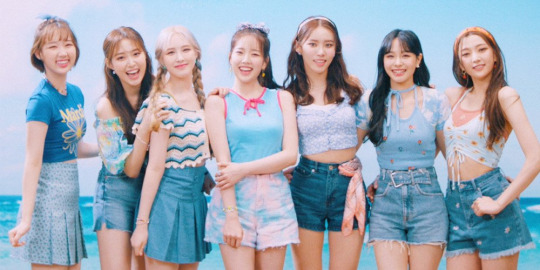
Girls’ Generation(Into the New World era-Gee era)
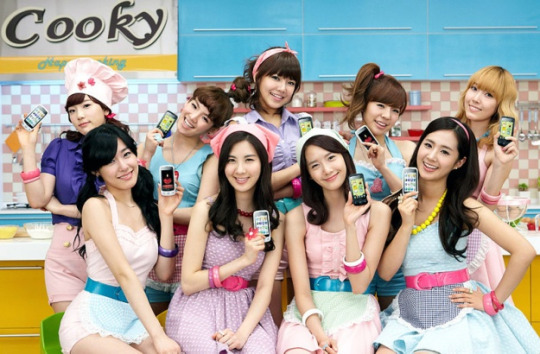
TWICE(Like Ooh Aah era - Heart Shaker era)
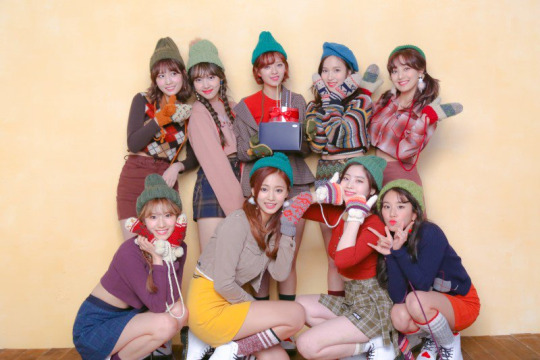
SYZYGY
An unconventional girl group with a unique sound. Despite their enormous amount of talent/skill , they haven’t been as successful as their small company had hoped. However, they continue to invest everything they can into this group much to the displeasure of the other idols under the company. Will their burning hot passion find success with the masses or, will they disband early leaving their company in complete ruin?
- Members

Hu Tao (leader, main rapper, vocalist)
Fischl (lead vocalist, lead rapper, maknae)
Mona (lead dancer, vocalist, visual)
Rosaria (main dancer, vocalist, rapper, oldest)
Xinyan (main vocalist, dancer,center)
- Real World Inspirations
Dreamcatcher (Chase Me era - Odd Eye era)

1NB (Stalker era - Once again, Winter era)

1MP@CT [prounced Impact]
A previously underrated boy group that seemingly appeared out of thin air on the #1 spots of all major top music charts. Most attribute their overnight success to their newest song going viral on social media but, some who work within their company secretly wonder if it has anything to do with the CEO’s private life and, the new anonymous investors. Regardless, they have made a name for themselves. They have a work ethic like no other and, will do whatever necessary to rise to the top. Even though fans are starting to worry their agency is pushing them too far. Will they become legendary performers the kind that future generations remember by name or, will their boss’ dirty little secrets make them guilty by association to the press when/if the time comes?
- Members

Baizhu (leader, lead vocalist, lead dancer)
Dainsleif (main rapper, lead dancer, maknae)
Scaramouche (main dancer, lead rapper, oldest, center)
Albedo (main vocalist,visual)
- Real World Inspirations
Big Bang (Fantastic Baby era - Bang Bang Bang era)
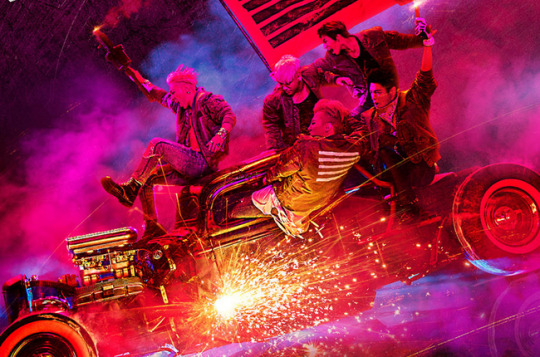
ATEEZ (Wonderland era - Fireworks era)
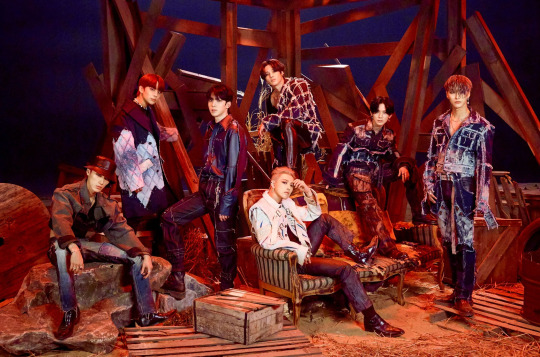
B.A.P (Badman era - Hands Up era)

DoDoCo
A junior girl group for kids/tweens made(and managed) by Alice to promote her daughter Klee and, have her gain experience for her dream of being a real idol. Although they perform, act, model and, release music similar older groups they still are children so, their concepts are always wholesome feel-good things to appeal to kid’s even younger their age or, younger. They also don’t have the same restrictions or, work hours due to their age. This group is very popular with Elementary schoolers and, sometimes even their families but, can be annoying to anyone older due to how cheesy it all is.
(Note: I don’t personally agree with kids being idols irl especially some I’ve seen that look like older teen/adult idols it’s scary. However, since it is a thing that exists and, this is a fictional head canon let’s pretend this is a world where none of them get hurt and can live pretty normal lives during & after their time as idols if they choose to do so. I just didn’t want to leave a playable character/important story character out of the AU entirely. Also, Sayu would be here but since she’s not officially released yet and, we don’t know any story about her I think it’s best for her to join later.)
- Members

Klee (leader, main dancer, vocalist, maknae,center)
Diona (main rapper, dancer)
Qiqi (vocalist, oldest)
Yaoyao (main vocalist, rapper)
- Real World Inspirations
RE:KIDS ANGEL (Ocean era) note: also their only era so far it seems but, apparently RE:KIDS is a larger thing with many other kids kpop groups so I assume others would have a similar concept.
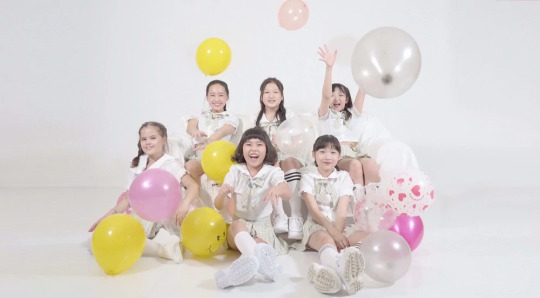
CutieL (Debut era - Jungle Journey era)
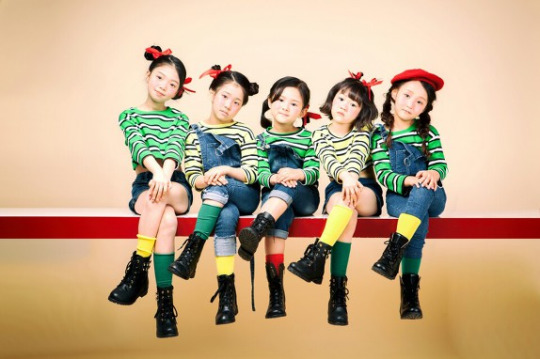
Dandelion
A girl group that has stayed at the top for the past 7 years known for their elegant concepts although, they have had other concepts in the past(sexy, cute, etc.). Not only is Dandelion super famous but, each member has their own solo careers just as successful. Outside of the group Jean is known for her solo albums and, charity work. Lisa is known for her modelling career and, secretly is a successful author under a pen name. Eula is known for her many wins on dancing contest shows and, the many important roles she plays in dramas. Since this year marks the dreaded 7 year curse fans worry they might disband or, go on a permanent hiatus. Before this year they seemed inseparable to fans but, something happened during their last tour. Jean and, Lisa who were known to be best friends suddenly won’t even sit next to each other. Eula who was usually more reserved during interviews is having to do most of the work since they’re just awkwardly sitting on the opposite sides of her. Eula has never been the best at public speaking and, her blunt responses are causing antis to go on huge smear campaigns on social media. Jean who previously wanted to renew her contract is thinking about starting her own company. Lisa who previously wanted to renew her contract now wants to leave and, join a modelling agency. Eula still wants to renew her contract but, she doesn’t want to be solo yet. She is trying her hardest to get the group back together but, her harsh personality is only making the problem worse she feels. Will they stay together or, will they split? And if they stay together, will it be the same Dandelion fans fell in love with or, are some bridges burned forever?
- Members

Jean (leader, main vocalist, center, dancer)
Lisa (main rapper, visual, sub vocalist, oldest)
Eula (main dancer, vocalist, maknae)
- Real World Inspirations
IZ*ONE (Violeta era - Panorama era)
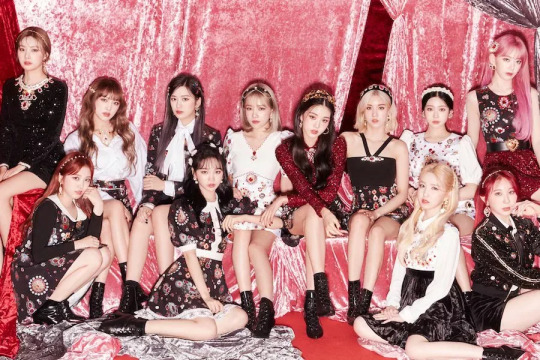
GFRIEND (Sunrise era - Mago era)
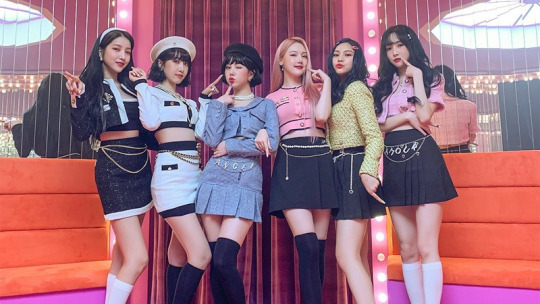
TWICE (Fancy era - Alcohol Free era)

Solo Idols
- Ayaka
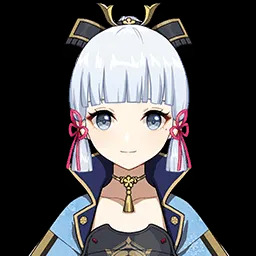
From a wealthy Inazuman family Kamisato Ayaka (known as Ayaka) shocked the entire nation when she decided to stop pursuing traditional dance(which she had earned many honors and, was famous for since she was a small child) and, instead go overseas to become an idol. Due to her connections it wasn’t long after becoming a trainee that she was put on the same survival show that formed 7evelUp!. However, her good luck ran out when after filming she got into an accident in her company’s car on the way to her company’s trainee dorms. Thankfully, no one was seriously injured but, she sustained an injury to her ankle that made her unable to perform for the rest of the show and, therefore was disqualified. She was a fan favorite and, everyone was heartbroken that she couldn’t compete. Due to her popularity, her company decided that if she could prove she was able to work after being healed they would let her have a solo debut. She far surpassed their expectations being even better than she was before, resulting in her debuting the same time 7evelUp! did. She doesn’t have any negative feelings towards those girls but, she views them as her rivals. She is quickly gaining popularity for her insane talent in singing, dancing, acting, modelling and, song-writing. She is known to the media as “The Idol Princess” for her family’s wealth, her talent and, her graceful demeanor. Don’t put her into a box though, she can pull off any concept with ease. The question is though, will her company allow her the freedom to express herself to the fullest?
- Real World Inspirations
Note: I am not saying she would be super similar to these artist’s work but, I am saying she has the range and, the potential to reach this level of fame. Since I can’t pinpoint a single solo artist that has what I think she would do I’ll put the ones I think have the insane talent and fame I think she would have as well as a similar feeling although it will take a while for her to get to their level
- IU
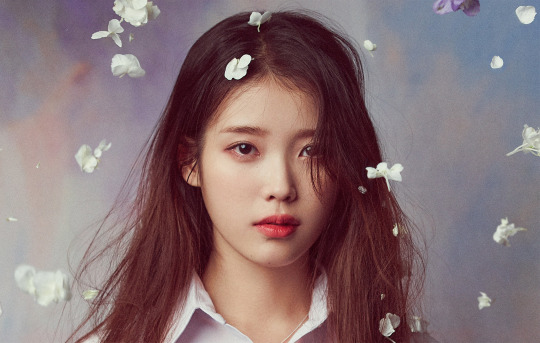
- Taeyeon
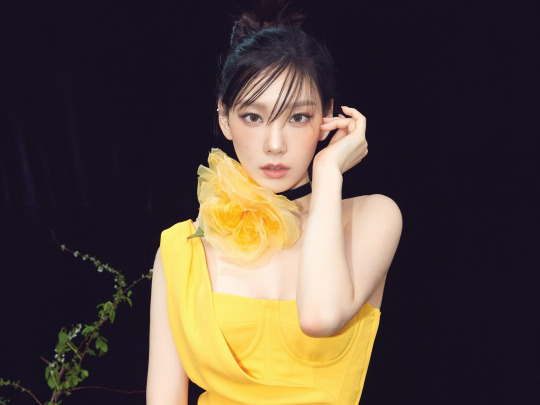
That was all of the Genshin Impact characters that I know enough about currently to feel comfortable making headcanons for them! Let me know what you think and if you make fanfic of or fanart of these ideas please credit me for these specifically and veechu for the idea of the idol au in general! Feel free to spread this post around if you want to or repost it too with credit. I also would love it if you tagged me if it’s on here or would be kind enough to send me a link to your work/work you find of it.
#Genshin Impact#genshin impact idol au#Genshin Impact headcannons#kpop#idols#Genshin Impact Idol Au Headcannons#Barbara#Amber#Yoimiya#Yanfei#Sucrose#Noelle#Xiangling#Hu Tao#Fischl#Xinyan#Rosaria#Mona#Baizhu#Dainsleif#Scaramouche#Albedo#Klee#Diona#Qiqi#Yaoyao#Sayu#Jean#Lisa#Eula
56 notes
·
View notes
Text
My thoughts on sex in YA books
Aka I will be furious if people use this to paint me maliciously.
CW for sex, genitalia mentions, HIV/AIDS mentions, masturbation, brief discussion of my personal experience of grooming
Prefaces: I don’t support underage sex. I don’t support sexualising minors. I had some very gross experiences as a teenager I wouldn’t want to happen to other people.
So, I’m currently in training with a charity to become a sex educator in U.K. schools. This means I’m the person who comes in, with a dildo and a condom, and shows you how to wrap up. This can happen from any age and we obviously tailor the experience to the age we’re teaching. We teach primary school kids the words for their genitals, how to practise consent in non-sexual scenarios. We also teach senior school young people that sex isn’t the way it looks in porn, that condoms are important for sex even if it isn’t penises in vaginas, and lots of other stuff.
I’m particularly invested because, for disabled and queer kids, this is a really unhelpful practise mostly. Most PSHE classes are like “penis goes in vagina, wear a condom or you’ll get pregnant” or, if you went to a school like mine “don’t have sex before marriage. Google pictures of STDs (yes they still called them that) and scare yourself out of having sex forever”.
So what we tend to use as a way of talking to young people is the media; books, shows, films, anything that we can show them that will promote a healthy discussion and make it accessible to them. We use a combination of all these to craft individual lessons for different age groups.
We talk about the realism and influence of porn, laws around sexting, and portrayals of sex in the media. A show that proves very popular with older kids (though we don’t show it to them as it’s an 18 and we only show 15 rated movies as the highest rating to our oldest students) is Sex Education.
Oh my god Sex Ed has helped SO many of our young people. Would I recommend it to 12 year olds? No, obviously not. But for the 16-18 year olds, it’s not unusual for one of them to bring up Sex Education.
If you asked my generation, or people a little older than me, they’d probably point to Judy Blume books as their own “Sex Education”. For people who don’t know, Blume wrote YA books that covered topics like menstruation, masturbation, and sexuality. Her books have been banned A LOT because of this.
There’s a really excellent old video from John Green (yeah yeah I know people don’t like him on tumblr but it’s an excellent video so) called I Am Not a Pornographer about the banning of his book Looking for Alaska.
This is all to say that it’s not uncommon for us to ban books that are aimed at teenagers that include sex. And what effect does that have? Overwhelmingly, not a great one. In training, we’re shown case studies of children who have had allegations of sexual misconduct ignored because they’ve used obscure words for their genitalia that parents have taught them to be polite. We have girls (SO MANY GIRLS) look appalled at the idea they might masturbate because that’s a BOY thing, that’s what BOYS do, we can’t do that - that’s dirty! We have people who don’t know that condoms aren’t just for penis-in-vagina sex. We have so much misunderstanding. Why? We expose children to the wrong kinds of sexuality.
Young people will find sexual material. That’s a fact. It’s online everywhere. Most easily-accessible porn is not ethically made nor made to show real people having real sex in a healthy manner. But that’s most people’s first example of sex.
If we condemn sexuality in YA books, we put young people at massive risk. I’m not saying let’s put some nipple clamps in Percy Jackson and have Harry Potter be really into BDSM. What I’m saying is that young people need to see healthy, respectful, consensual relationships in books. We need books that show consent as something that isn’t inherently sexual.
The first book I read where I saw a condom being used in sex between two people with penises was in Running With Lions by Julian Winters.
The first show I saw where autistic people were shown to have sex drives was Everything’s Gonna Be Okay.
We can’t shelter young people from sex. We’ve done that, and what’s happened? We’ve had generations of people who refuse to talk about it, and have unwittingly endangered not only themselves but others.
I’m a trainee sex educator and I didn’t know about undetectable = untransmittable until I read Full Disclosure - a YOUNG ADULT book about a teen who is HIV positive.
I was at risk because of this. I let people who had no right to my body and my emotions manipulate me because I didn’t know any better. I wasn’t taught any better. I went to a Christian school where all I knew was sex could hurt me. So when an older adult showed me affection, who could blame me for assuming it was fine?
We need to stop acting like “sex” is a dirty word. Not talking about sex to young people doesn’t make them not have sex - it makes them have uninformed, dangerous sex.
Yes of course there are lines to draw. Yes of course not every book gets it right. Yes of course we need to be extremely critical.
But this gross thing going on right now where we say “adults writing YA where their of-age characters have consensual, safe, healthy sex is wrong” is doing nothing but damage.
What we need to say is, here are some really excellent examples of books that get it RIGHT. So here are some of those:
Full Disclosure by Camryn Garrett
Running With Lions by Julian Winters
Red, White, and Royal Blue (NEW ADULT) by Casey McQuiston
History Is All You Left Me by Adam Silvera
The Miseducation of Cameron Post by Emily M. Danforth
So, in summary:
- Age appropriate exposure to romance and sexuality is imperative for the safety and development of young people
- Adults writing this material isn’t creepy - it just so happens that most people who write books are adults. Also, it’s hard to write about something when you’re right in the middle of it and haven’t quite got it figured out yet.
- I will personally attack you if you try and in any way, shape, or form use this to paint me as someone I’m not.
139 notes
·
View notes
Text
Andy on Asian Animation or SYAC: The Master Review 2
Let’s talk a bit about anime and Dobson’s work relation with it.
I think we can all agree, that starting from the late 90s and early 2000s on, anime and manga became extremely popular in the western world. Sure, Japanese animation was nothing completely new to us (Speed Racer, Nadia-Secret of Blue Water, Samurai Pizza Cats, Sailor Moon, Kimba and Akira e.g. come to my mind as properties already known in the west before 1995) but it really was around this time that thanks to “mainstream” stuff like Dragon Ball and Pokemon people became aware of how different Japanese animation was from western. Eventually resulting in the really good shit (like Cowboy Bebop, Black Lagoon, Kenshin and Heat Guy J) coming over and enriching nerd culture for more than just a few people who knew of it as an obscurity at that point. Now, if you know anything about Dobson, you likely know that his relationship with anime is rather… complicated to say the least. Or, to let him explain it with his own words…
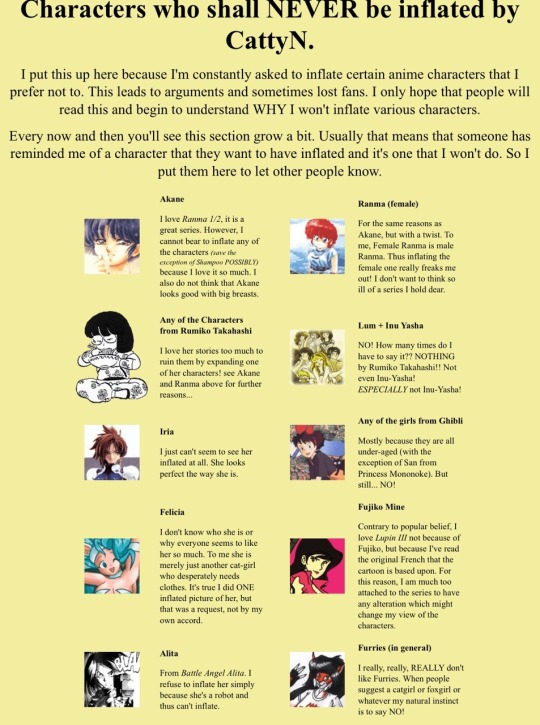
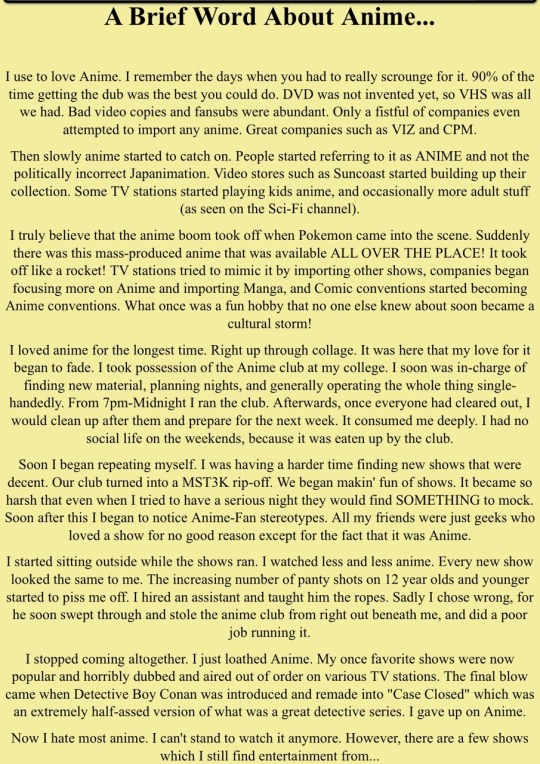

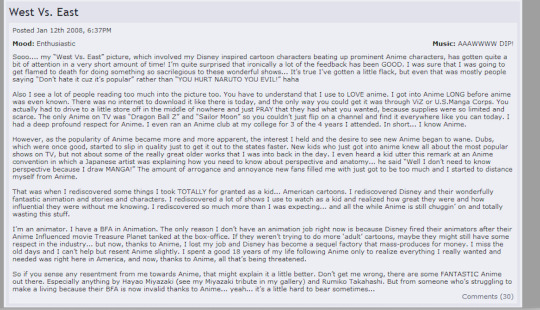
Dobson essentially likes silly and wacky 90s anime. But later on he hated anime in general, because it got too popular and a bad experience with an anime club in college soured his enjoyment of it. Furthermore, he put the blame on his lackluster art style and storytelling capabilities as seen in the likes of Formera, Patty and Alex ze Pirate, on anime in general, while also claiming that Disney pulling the plug on 2D animation is the result of the “anime inspired” Treasure Planet, meaning anime in a sense deprived him of his chance at working at his dream job and “ruining” western animation.

Which to me has always been ignorant as fuck. For starters, I can understand not liking certain stories or genres, either for objective or subjective reasons. But to hate on an entire nation’s form of entertainment (not just individual shows or genres), depriving yourself of the chance of potentially watching a lot of good stuff while also being rather insulting to these other works and people enjoying them? Especially when the stuff you can supposedly “stomach” has been rather simplistic compared to other things?

Second, blaming Japan for “poisoning” your art style? What, did the ghost of Osamu Tezuka possess you and FORCE you to put sweatdrops on your characters forehead while also going for the rather simplistic character style of Rumiko Takahashi, as well as emulating the slapstick of the likes as Slayers and Ranma ½?
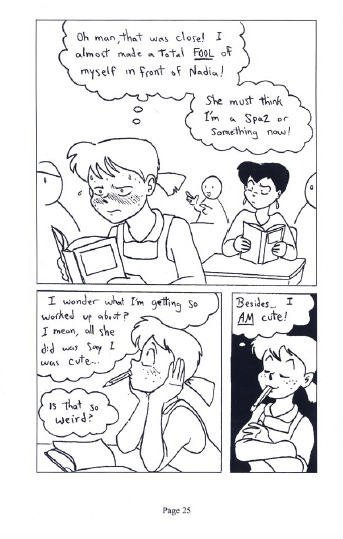
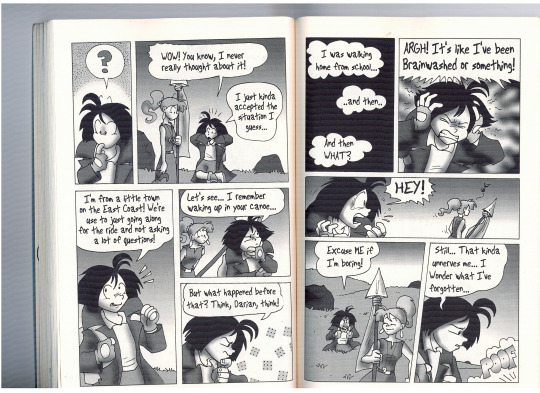
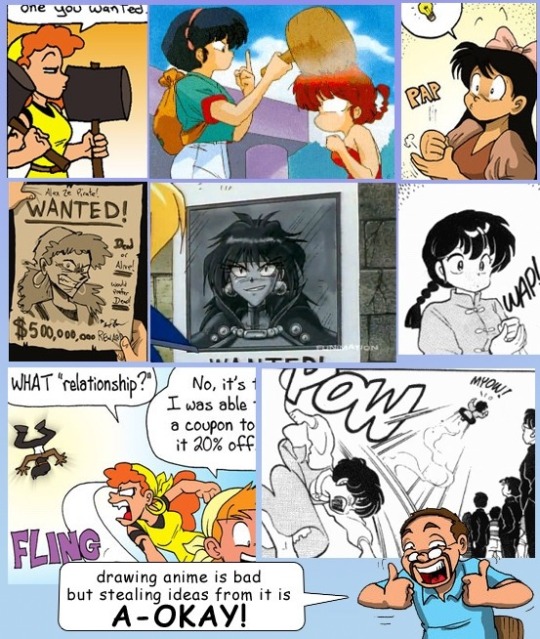
Next, if he had emulated them successfully, I say he would have actually managed to tell decent enough stories worth to read online. Not create Uncle Peggy aka “Discount Happosai” or the bland proto-Isekai known as Formera.

I mean, let’s give some context here: There have been people who successfully managed to emulate certain anime and manga aesthetics into western animation and make it work. Otherwise we wouldn’t have gotten the likes of Avatar-The last Airbender, Samurai Jack, the Animatrix, Thundercats 2011, Super Robot Monkey Hyperforce Go, Kim Possible, W.I.T.C.H, Megas XLR and Wakfu. You know, shows that are actually awesome as hell.

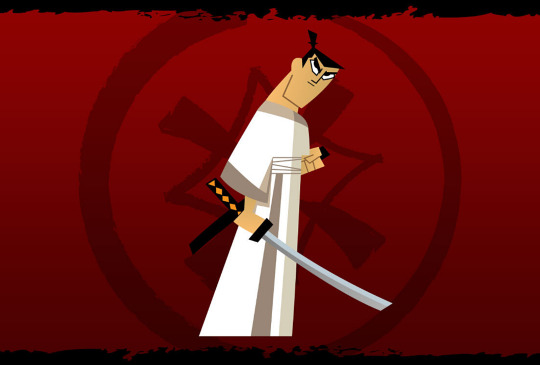
Heck, Dobson’s favorite animated show of the last decade, Steven Universe, is heavily inspired by anime aesthetics to the point of being embarrassing.
But Dobson… well, he emulated anime aesthetics in his work the same way as these crimes against animation did.
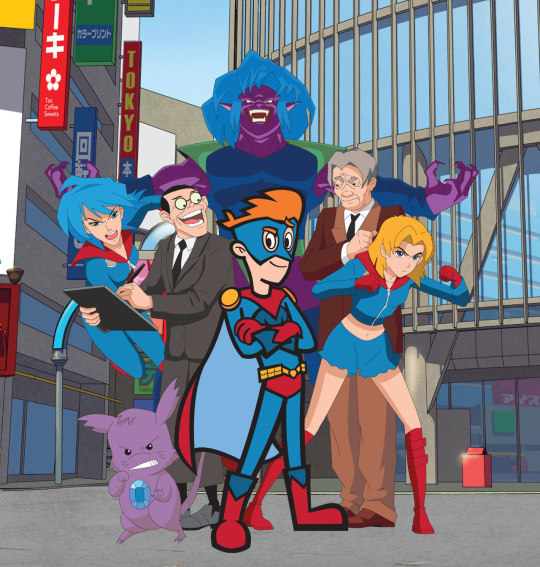
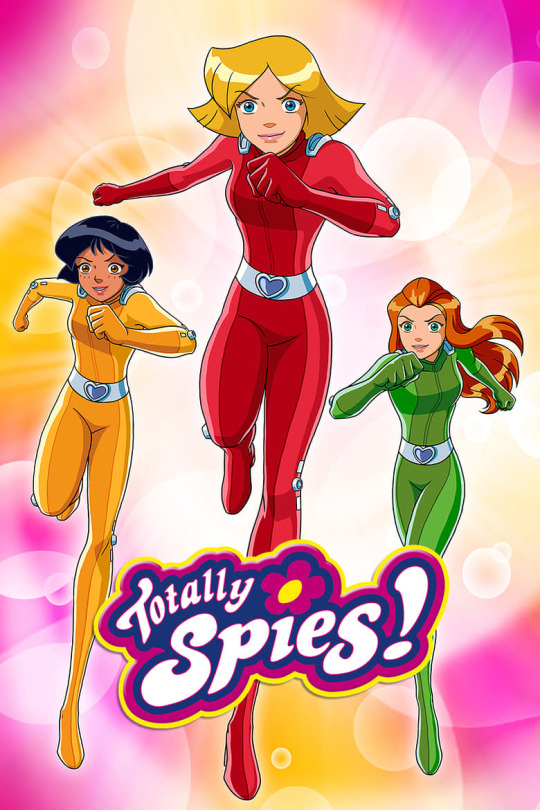
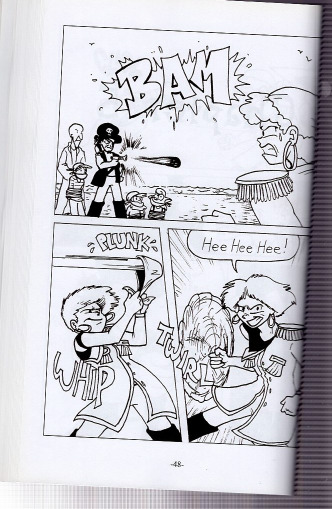
Combined with his general shortcomings as a storyteller it is no wonder his initial comics did not do well.
Lastly, and sorry for digressing here a bit, but if the Wikipedia entry on Treasure Planet is something to go by, there was no real inspiration by anime involved in making this movie.
Supposedly the idea of making an animated Treasure Planet in outer space movie was already pitched by Ron Clements WAY BACK in 1985 but only came to be after Michael Eisner greenlighted stuff in the late 90s. Design wise the movie was supposed to look 70% traditional and 30% sci-fi inspired and people took inspiration for the art style by illustrators associated with the Brandywine School of Illustration. A western style of illustration established in the 19th century, that had a big impact on the illustration styles for many 19th and early 20th century adventure novels and short stories.
What, is anime supposed to be the only form of animation allowed to have sci fi elements or steampunk in it? Fucks sake, The Lion King and Atlantis, which came out one year earlier to Treasure Planet, were likely more inspired by anime. Don’t believe me? Watch Atlantis and then a certain anime by Studio Gainax called “Nadia-Secret of Blue Water”. Or read up on the controversy surrounding the two.
The truth is, it is not entirely clear what caused Disney to shut down 2D feature film animation in the early 2000s. In fact, if anything, most people put the blame on Michael Eisner and a certain change in the publics taste in movies in general, combined with Disney trying to turn almost every movie they had into a franchise via cheap follow up movies on video and DVD.
And even if Disney did not shut down, are we really supposed to believe that a certain guy with fedora would have made it big at Disney to the point Alex ze Pirate would have been made into a feature film?
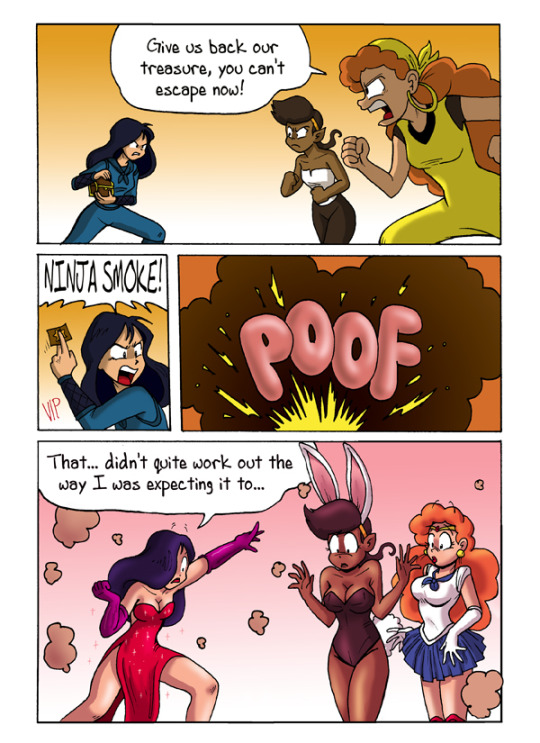
But Dobson could never quite understand this and instead of “reinventing” himself properly, he would rant about anime and its fans in one form or another…

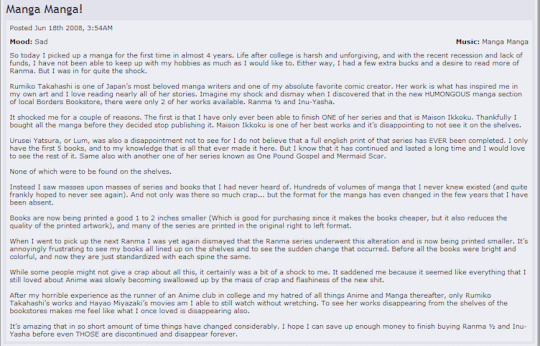
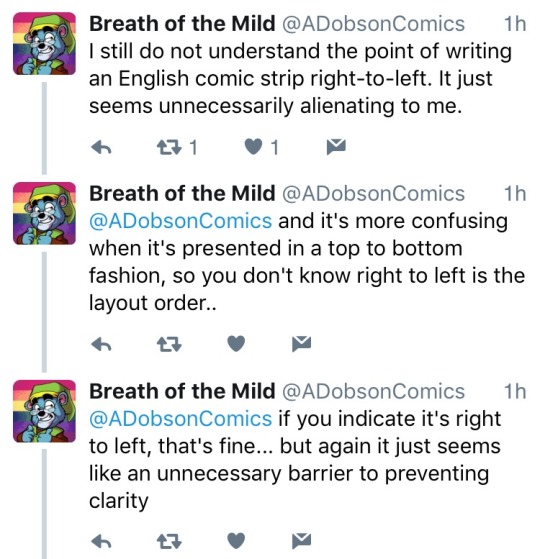

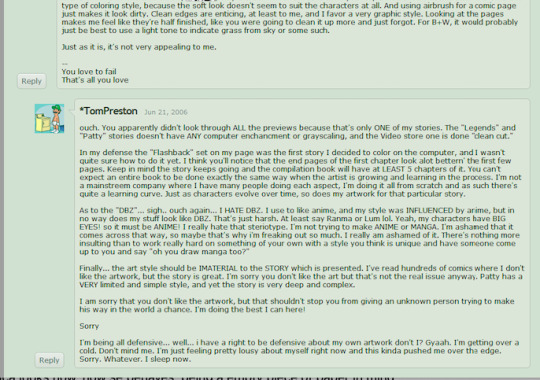
And on the peak of his hissy fit create this little art piece he baptized Anime Sux. Alternatively “West vs East”. Or as I like to call it, slap a jap.
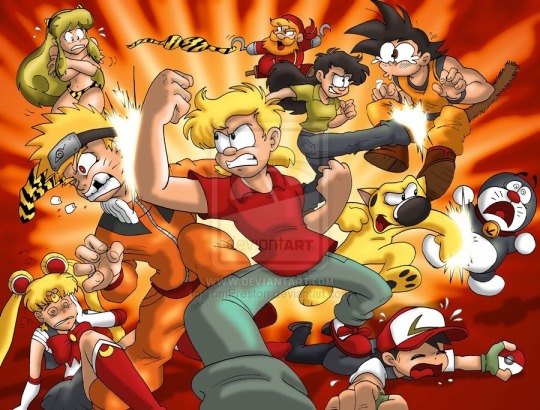

Now, the pic was done in 2008 and Dobson claimed sometimes in the last decade, that he no longer holds his old opinions. Unfortunately, by that point he would also more or less use the chance to vent in his webcomic about anime (or rather its fans), which brings us finally back to SYAC.
While Dobson never outright thematized in more detail WHY he hates anime and manga in SYAC (likely cause if his comic reasoning was even slightly like his reasoning in his blogs, people would have torn him apart like a bag of paper) he did use the format to punch down on anime fans and their preferences.
For example, for someone who has a 4chan story going around of having been rather arrogant towards others in college for not liking Ranma ½, Dobson has THIS little college related comic to show off, where he portrays an aspiring manga artist as a delusional jackass.
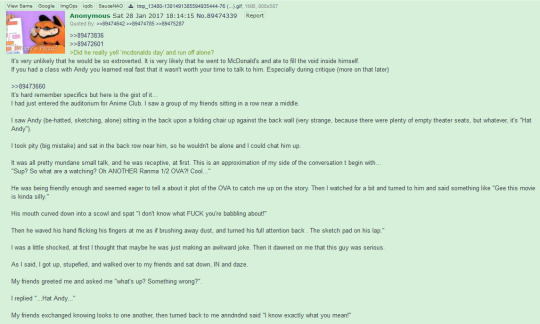
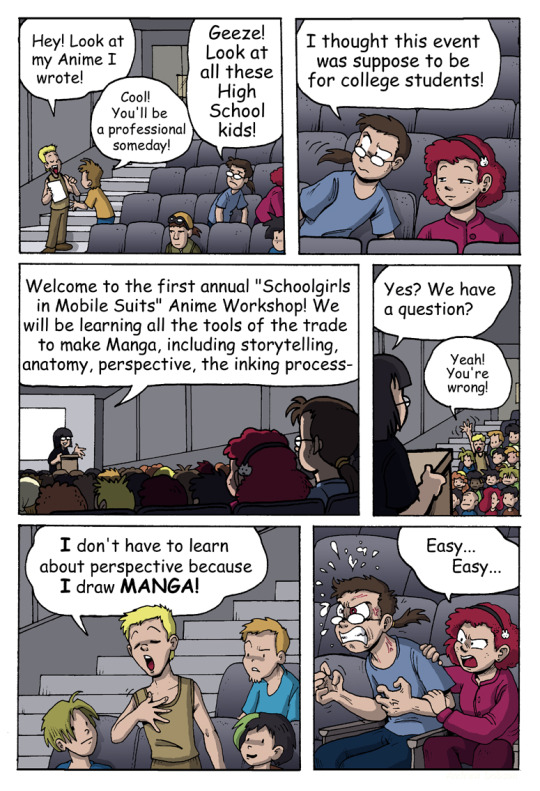
Then in this strip titled manga, his manga fan is essentially portrayed as a young woman dressing up like a very stereotypical high school anime girl, who is in the wrong for even just DARING to draw her comics in the direction manga are read.

On one hand, I get Dobson’s point. She could be at risk of alienating a market of readers as she is obviously drawing for a western audience. Then again, if she doesn’t draw a traditional western comic but a manga, why shouldn’t she? I mean, as long as she enjoys it, which I assume she does as she seems genuinely just happy when stating that she likes manga, why not let her? Plus, this comic was drawn in the late 2000s. I think by then most people kinda knew how to read from right to left, so Dobson’s claim she would alienate or confuse people is kinda redundant. If anything I find a) Dobson getting angry at her just very petty (just let her have fun) and b) portraying a western manga fan as someone who would be confused by the sheer idea of reading stuff from right to left is also in itself just really dumb and insulting. What is Dobson trying to imply? That anime fans are so stuck in the way they consume certain media, they can’t act according to “western standards” again?
Then there is this strip where yet another female anime fan is essentially portrayed as the embodiment of how “ignorant” manga fans are of the idea of different art styles...
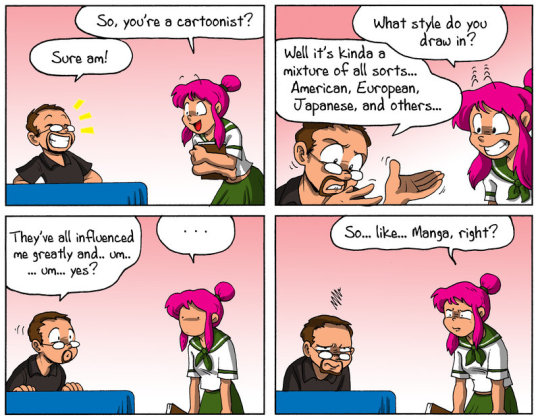
Which becomes rather laughable once Dobson describes his style as a mixture of European, American and Japanese. Why? Because he is the one oversimplifying things, rather than the anime fan.
You see while anime and manga of all sorts do share certain aesthetics (like the black and white art style, emphasize on the eyes of characters, the way hair is drawn, recurring tropes within certain genres and so on) style wise (both in art and storytelling) there can be severe differences, depending on the artist alone. Akira Toriyama’s style differentiates significantly from the likes of Eichiro Oda, Rumiko Takahashi, Kentaro Miura, Tezuka, Kaori Yuki and so forth.
The same also goes for many western artists. Herge had a significantly different style from Uderzo and Goscinny. Don Rosa has a different style in which he drew Scrooge McDuck than Carl Barks did. Rob Liefeld and Jim Lee draw mainstream superheroes differently compared to how Jack Kirby, George Perez and others did. Heck, Ethan Van Sciver and Jim Lee were closely associated with Green Lantern in the 2000s and look how they differentiate.
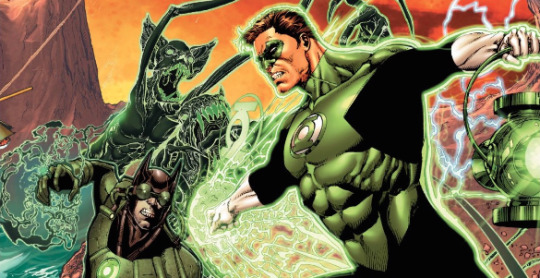
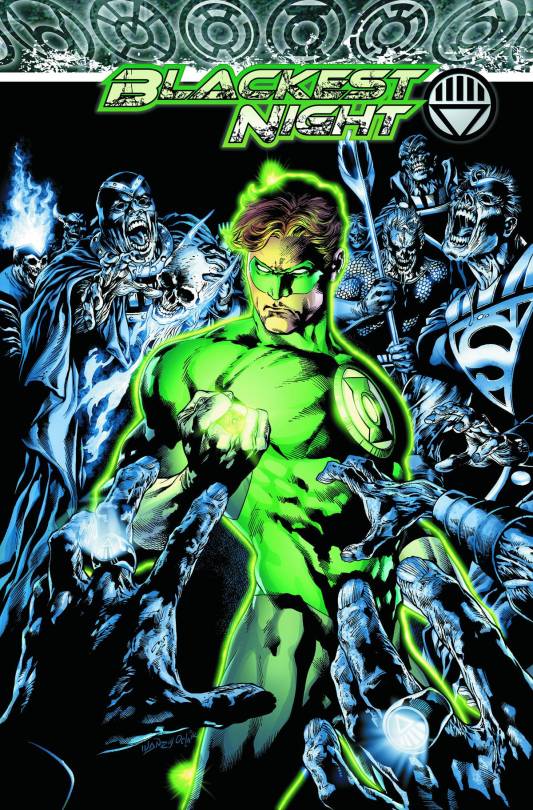
Which btw is the kind of skill level Dobson would have needed to have, to make it in the mainstream industry
So when Dobson says “I draw in a combination of American, Western and Japanese” all I can think is the following: THAT DOESN’T NARROW IT DOWN! WHAT THE HECK HAVE YOU LEARNT IN COLLEGE ABOUT COMICS? WHICH ARTISTS, WORKS AND STORYTELLERS DO YOU TRY TO EITHER EMULATE OR HAVE BEEN INSPIRED BY?
Then there is this little thing…
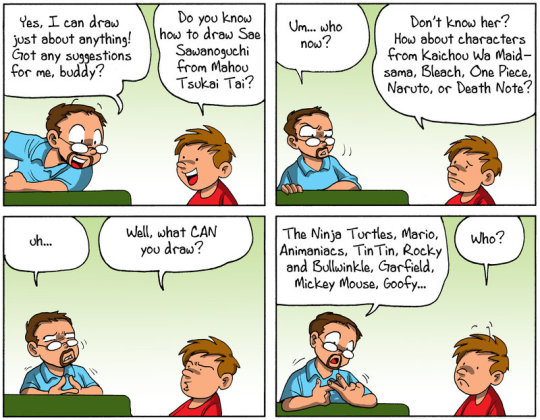
Where do I even begin? How about the fact that Dobson’s hand in the last panel looks like he has lost a thumb? The fact that the little boy, anime fan or not, is aware of Sae Sawanoguchi, a character from a short lived OVA and anime series from the 90s, which considering his age, I kinda doubt he would be aware off. Unlike Dobson, who got into anime in the 90s and admits in fact within the posts I loaded up earlier, that he had watched the anime in particular, known in the west as Magic User Club.
Then there is the implication by Dobson, that anime is so “corruptive” as a medium, little kids don’t even know the most basic characters in western animation because of it. I expect in a next panel, that all of sudden some 50s PSA guy comes along and lectures me that if I want this kind of thing not to happen at MY convention, I need to teach little kids more about the GOOD western animation, instead of the BAD eastern one.
Then there is this rather unflattering portrayal of a shonen ai/shojou ai fangirl…
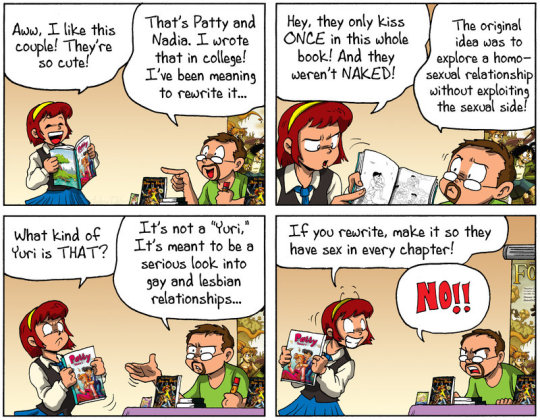
Which makes me laugh cause honestly, even some of the worst shonen ai and shojou ai can do better in portraying a “realistic” gay relationship than Patty if you ask me.
Also, as much as I think fangirls can be extremely thirsty (I have read my fair share of extremely stupid yaoi and yuri fanfics) I think that in hindsight Dobson is really not anyone to complain about shipping obsession and sex when he himself has KorraSami, the Ladybug fandom and a certain rat pirate under his floppy belt.
As you can imagine, Dobson would get heat for those comics, considering how he himself has been greatly inspired by anime and manga for his major comics. And while I don’t have any explicit deviantart posts of him reacting to criticism in that regard, I do have this comic which addresses it directly.

And yeah, if I were schoolgirl number 4, I would just sigh and walk away after telling Dobson that his mistakes and shortcomings are not related to having consumed anime, but rather by what sort of anime (and other stories) he had consumed and the amount of effort he had put in creating his stories instead of emulating just something more popular. Plus, if you really want people to draw more from life, how about drawing more from life yourself down the line? And no, tracing Star Wars movie frames does not count.
Finally, Dobson, considering how very little most people think of your work, I say mission accomplished: People have learnt from your mistakes and know not to be a Dobson.
And at last, there is this comic, which kinda wraps up Dobson’s “vendetta” with anime and manga fans within the pages of SYAC.

By trying to mock anime fans and make them look just as shallow as he is. I at least suppose. Honestly, the message of this comic is rather muddled. On one hand, I would say the strawman accusing Dobson hates anime just because it is popular is very simplified. After all, Dobson has made his reasons for not liking anime clear in a few more details.
It’s just that the details in and on themselves in real life are still rather shallow and boil down to a lot of personal bias rather than an objective criticism of actual flaws. Which I think is worth pointing out.
But frankly, what is Dobson trying to say or point out here? That the strawman is not so different or even dumber than him, because he hates Justin Bieber for “shallow” and superficial reasons too?
Okay, this doesn’t quite work as well as Dobson wants. First, the argument Dobson’s strawman makes is in huge parts based on some verified statements Dobson made for not liking anime. Second, he just says a name and that triggers the guy to express his hatred for Bieber. We don’t know why the guy hates Bieber and you could make in fact the case, that he hates him not because he is popular, but because he has a genuine issue with the artist, his work or his behavior as a human being. Third, if you want to make yourself look like the better person Dobson, try to argue with the guy and make solid arguments why you don’t like anime. Instead you just deflect the criticism by changing the subject and then try to make yourself look like the “smarter” person in the room by mocking your critic in the most condescending manner.
Which as I think about it, sounds like your modus operandi on twitter and tumblr.
Weirdly enough, that more or less marks the “end” of Dobson tackling anime fans and the beef he has with them within the pages of SYAC. Despite how much Dobson’s negative reputation especially in early years was build around him hating on anime and belittling its fans, he didn’t really do more afterwards in the Dobson focused pages of SYAC. And mind you, those strips were also separated by other strips in-between, focused on Dobson just being at conventions.
Unfortunately for him, the strips didn’t really help in any way to diminish that negative reputation and instead just confirmed for many, that Dobson can’t handle criticism about his flawed opinion on anime. If anything, it just made people think even less of Dobson, as the strips just painted him as someone who would rather portray his critics as strawman he can be “rightfully” annoyed at, instead of fellow humans with slightly different tastes in entertainment, who are still worth listening to.
So, now that we have the anime fan related “annoyances” out of the way, what other sort of silly problems in making webcomics would Dobson cover in his strips and are “relatable” to everyone?
Lets see some of these examples in the next part.
#anime / manga#manga#Andrew Dobson#fuck you Tom Preston#Tom Preston#syac#so...you are a cartoonist#so you are a cartoonist#review#webcomic#comic#adobsonsartwork#adobsoncomic#adobsonartworks
22 notes
·
View notes
Text
Modern Dragon Designs - Where they came from
Your regularly scheduled werewolf facts will return soon. For now, we provide this special, because you may not realize this, but I love dragons. There’s a reason one of my protagonists is basically obsessed with dragons.
Once upon a time, there was a movie - I don’t see anyone talk about it, I’m not even sure how many people are familiar with it...
It’s called Reign of Fire.

This movie shaped the modern Hollywoodian concept of dragons. Seriously, it did. Hear me out.
Released in 2002, Reign of Fire was a movie about - essentially - dragons as that age-old trope of “let’s take one monster and turn them into an overpopulated zombie plague so we can use them to tell a story about humans and make the monster just this brainless evil locust swarm backdrop.” This has happened to a lot of monsters by now.
But wait, these dragons aren’t like the dragons you might be used to: these dragons were completely redesigned from the ground up by the filmmaker(s) in order to make a more “realistic” and “animalistic” dragon that was acceptable by Hollywood, who generally views “dragon movies” (like so many other fantasy things...) as cheesy and silly. Market your movie as a film about dragons and you probably won’t get a deal. Well, turns out, coming up with your own gritty dragon designs worked!
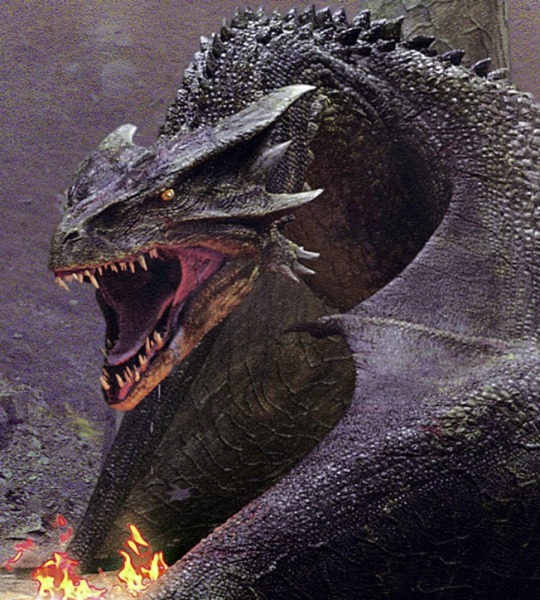
Doesn’t this remind you of every other dragon you’ve seen in a movie for the last, you know, 18 years? Although it actually looks quite a bit cooler than those other ones that came after it
Please note that while I may sound sarcastic, jaded, and often maybe a bit scathing, I mean nothing against the creators of Reign of Fire or director Rob Bowman. I watched the movie in theaters when it released. I applaud Bowman for coming up with unique and interesting dragon designs, in order to have a different take on the creatures, so that they fit the story he wanted to tell, instead of doing what so many people do and completely co-opting concepts without trying to alter them to fit anything and... yeah... okay, I’m not going to talk about werewolf things in this post. Getting back on track:
What I don’t applaud is everyone ripping off Reign of Fire for their own dragons, doubly so because most of these people didn’t even take into account the reasons why it was designed that way. They should have left his dragons alone and come up with their own thing, but at least I guess Bowman can go down in history as the man who designed every Hollywood dragon for over a decade to come - with no signs of stopping - even down to the tail shape.
On Vice, you can find an article and interview with Rob Bowman, the director of Reign of Fire, discussing how he came up with this dragon design and how influential it has become. I highly recommend giving it a read.
Please note the Vice article is clearly written with the bias of someone who “can’t take dragons seriously,” so it’s also a good look at the Hollywood mindset about dragons and how much Hollywood treats fantasy in general like garbage (jerks).
It’s impossible to pretend this movie didn’t basically reshape modern dragons. Let’s get to the details...
Animalistic Design

Dragons in popular culture are generally - or at least they were generally - assumed to be powerful, intelligent creatures, often of a higher nature than humans and other mere mortals. They may be good or evil, but one can’t understate that traditional fantasy dragons are regal and majestic either way.
Reign of Fire wanted to usurp the majestic, intelligent dragon image, creating a smaller, hunched, knuckle-dragging sort of dragon that looks more like an animal - like a pteranodon. This is because the dragons in Reign of Fire are not exceptionally intelligent, noble beings that speak and hoard gold and have the wisdom of the ages. They are brutal hunters that set things on fire and eat everything smaller than them. So this design choice was a conscious one and a smart one.
The dragons in Reign of Fire are meant to be more scientific, more plausible, and also simpler, in a manner of speaking. They are not colorful, magical, ancient fantasy dragons...
Trouble is, everyone took cues from this design for their talking wise noble fantasy dragons, and it... doesn’t really work, at least if you ask me.
The dragon design in Reign of Fire looks like an ancestral throwback, an evolutionary ancestor to the intelligent, talking fantasy dragon, although they are smaller. They’re hunched, they haven’t evolved forelegs independent of their wings... you get the idea. Take a look at the “proto-drakes” in World of Warcraft versus the ordinary drakes, which have tiny dangly T-rex forelegs that haven’t fully developed yet, so they walk like the Reign of Fire dragons.
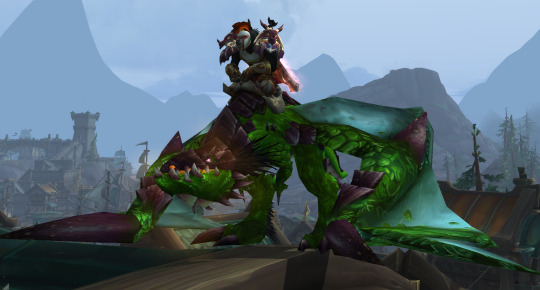
A proto-drake in World of Warcraft - also say hi to my worgen warrior
So many things taking this design for their intelligent, “higher being” dragons seems kind of... odd to me, to say the least. Unfortunately, Hollywood decided that’s the only way moviegoers can “take dragons seriously,” so here we are.
“Wyvern” - Two Legs vs Four

Municipal arms of Stjørdal, Norway
In medieval heraldry, there came to be a creature called a wyvern. Now, the etymology on the term “wyvern” is a little shaky. It originally didn’t specifically refer to a “two-legged dragon.” It is thought to mean/be derived from words meaning anything ranging from “asp” to “light javelin,” and essentially boils down to a flying serpent. It is noteworthy, of course, that the word “dragon” basically just means “serpent” too.
In heraldry, though, “wyvern” came to refer to a two-legged dragon - at least, if you ask the English, Scottish, and Irish; elsewhere in Europe, they may not be so picky. And now, in modern pop culture (such as Dungeons and Dragons), we often use it in the same sense.
Wyverns weren’t really a “thing” in folklore, just as dragons in folklore didn’t look like our modern idea of a dragon. It’s debatable whether the father of our modern concept of dragons, Fafnir (from whom Tolkien drew inspiration for Smaug), even had wings at all; he was essentially a serpent, perhaps with legs. Point is, wyverns come from heraldry, especially the specificity of two legs versus four.
So now you know why you might see a lot of people (myself included) referring to this design as a “wyvern design” for a dragon.
Dull Coloration - Grey and Brown over Red, Blue, Green...
There’s something else - something very important - that Hollywood took from Reign of Fire... the concept that dragons aren’t pretty colors and are, in fact, various hues of grey and brown, and any more contrasting colors are just vague indications instead of bright red scales.
Now, Reign of Fire obviously did this because - again - they were going for the more animalistic, natural look as opposed to the mysterious majestic magical being look. Okay, that’s fine. But then Hollywood decided that fantasy, too, has to be devoid of dragons with bright colors.
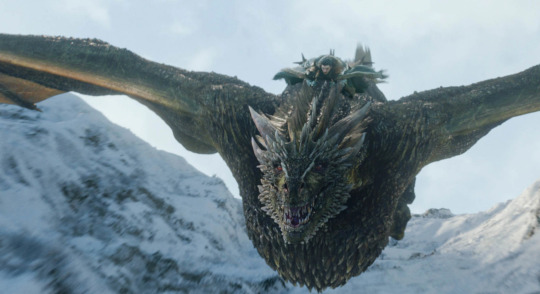
The green dragon in Game of Thrones
There are countless examples of this in modern media. Any dragon that was previously brightly colored has been dulled pretty much to an extreme. Sometimes you might catch a fleeting glimpse of them looking like a brighter shade, but it was probably just a trick of the light. Why? Because all dragons are desaturated to the point of being almost indistinguishable by color.
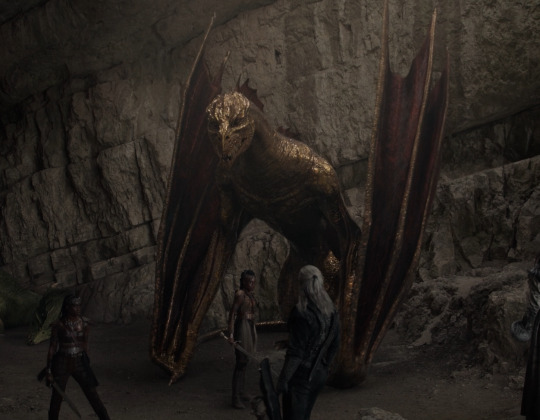
The golden dragon in The Witcher Netflix series
This is also why you see so many mods on the Skyrim Nexus called things like “true red dragon.”
There are plenty more examples of this - I’m sure you can see the difference when you look at those dragons and other modern film dragons over, say, something like this...
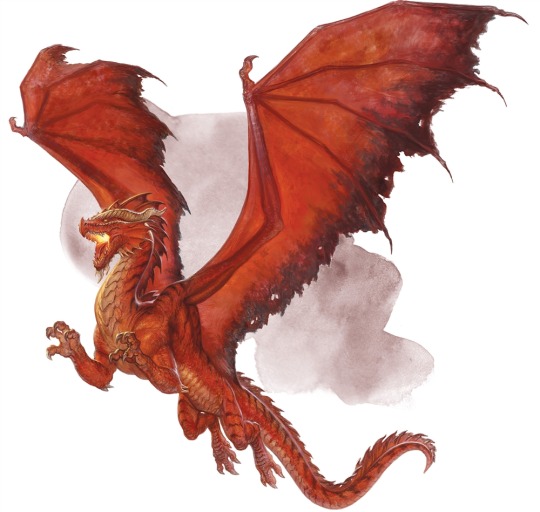
Red dragon in D&D
And now we move on to...
The Fire Breathing - Chemicals, not Magic
Bowman insisted on ditching traditional fire breathing (you don't want the audience wondering whether the dragon's mouth is being burnt up with every flame) and again looked to the animal kingdom for inspiration. The king cobra, once again, was a great starting point. It doesn't spray fire, but it can spit its venom. Even more useful was the bombardier beetle, which shoots two chemicals from its abdomen that, once mixed, create a hot, burning spray. Bowman used these real-world examples to inspire his own dragons. They don't breathe fire exactly, but rather spit chemicals from two different sacks in their mouths that, when combined, ignite. "That's anatomy. That's already been designed, so we're going to draw from there," he said.
(quoted from the Vice article linked to earlier in this post)
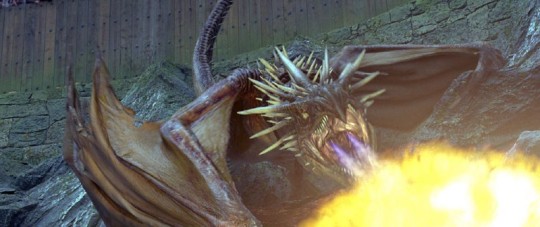
The Hungarian Horntail in Harry Potter and the Goblet of Fire - fire is streaming from two separate organs in the mouth, but they aren’t chemicals mixing together like in Reign of Fire...
The director of Reign of Fire wanted his dragons to be more natural in that they breathe fire through organic means, based on chemical reactions, instead of the usual dragon magic. But lots of people loved this “mouth flap”/”mouth organ” design with “streams” of fire coming from the mouth instead of fire flowing directly from the dragon’s throat, so now you see it pretty dang often.
Horns? Brow Ridges!
Another thing that is basically out now in dragon designs is the real horns of many traditional dragons, like Spyro, and like the dragons in Dungeons & Dragons used to have.
These days, it’s all about brow ridges and big spiny scales that aren’t separate horns, they’re just big pointed scales or piles of scales or bone ridges - and they aren’t a different color than the dragon’s scales, either, pretty often. And, in general, dragon’s horns have become much smaller and far more numerous, and more like spines/ridges, as opposed to the great, sweeping horns of classical dragons.
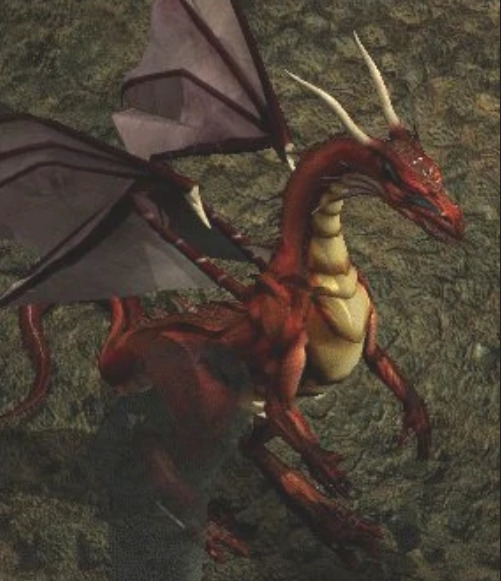
Firkraag, the red dragon, in the D&D video game Baldur’s Gate II, from 2000
Firkraag is a very traditional dragon. Now, while Dungeons & Dragons has generally kept more traditional dragons (yay!), they did fall into the brow ridge horn thing - although they, thankfully, didn’t make the horns smaller and subtler and more numerous little spikes, like so many other modern dragon designs. They also went with the brow ridge horns for tieflings (once humans with demon blood, then some weird thing in 4E, and now I think they’re humans with demon blood again), as opposed to the ordinary horns of the tieflings in previous editions of D&D.

Skyrim dragon head concept art
The Desolation of Smaug(’s design)
Here is... a big one. Here, we’ll talk some about the production of The Hobbit films over time, so we’re going behind the scenes.
Alright, so we all know Smaug, probably, by pop culture osmosis if nothing else. He is the quintessential dragon. He’s basically the founder of all Western dragon concepts: he’s big, he’s red, he hoards gold, he’s extremely intelligent and talks, etc. You get the picture. Every dragon that we have borrowed at least something from Smaug. And, in turn, he was inspired by Fafnir, the father of all our dragon concepts, from Norse mythology - but Tolkien took it all a step further and created the concept of dragons that we have today. Or, well, the not Reign of Fire ones. The fantasy ones.
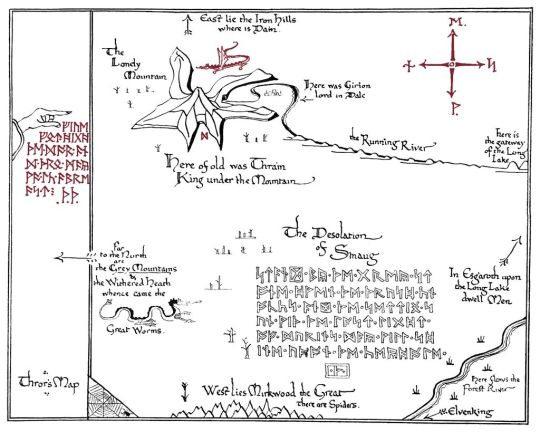
A map drawn by Tolkien: notice the winged, four-legged Smaug over his mountain
During the first Hobbit movie, An Unexpected Journey, we see Smaug attack the Lonely Mountain...
In this clip, you can plainly see that Smaug has four legs. This was actually edited slightly for later editions of the movie, or so I’ve heard (I haven’t watched any later editions).
I can tell you for certain that when I saw the theatrical release, it was like this, too. It is apparent throughout the scene that Smaug has four legs and wings, separately. I know because I was paying very, very close attention, because I was going to be very upset if Hollywood turned Smaug into a wyvern.
Well, they did - later.
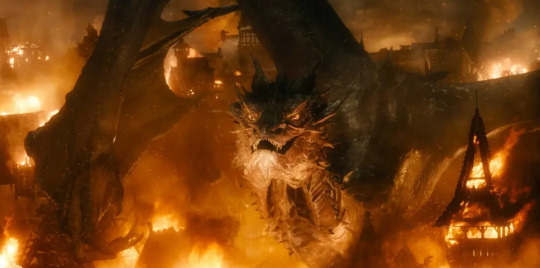
Smaug the wyvern looking like just another slightly different take on the bog-standard Hollywood dragon
Apparently, some studio exec decided that having a traditional fantasy dragon, even if this dragon happens to be frelling Smaug himself, would not be okay in this modern Hollywood world. So we ended up with a dull reddish spiney hunching knuckle-dragging wyvern with an angler mouth (I’m sorry; I really am sorry if you like the design, that’s totally fine, it’s a fine design, I am glad you enjoyed it, but Smaug shouldn’t have looked that way IMO and forgive me but I am still in pain over it) in place of a more traditional dragon that held more to things like, I dunno, how Tolkien himself drew Smaug. Smaug’s movie design flies right in the face of that and destroyed our chance to finally see a proper traditional dragon done justice on the big screen.

Tolkien’s art of Smaug - note the position of the forelegs, separate from the wings, like in the earlier map
This is all just one big example why we should be thankful that The Lord of the Rings films were all shot in one go, so no one could alter important things like the design of the fantasy genre’s father of all dragons, in the middle of production. Of course, the production on The Hobbit movies was a nightmare at best, as you can read about in assorted other articles, and Peter Jackson was very unhappy with what the studio had him do to the series. All of that is just another story, I suppose.
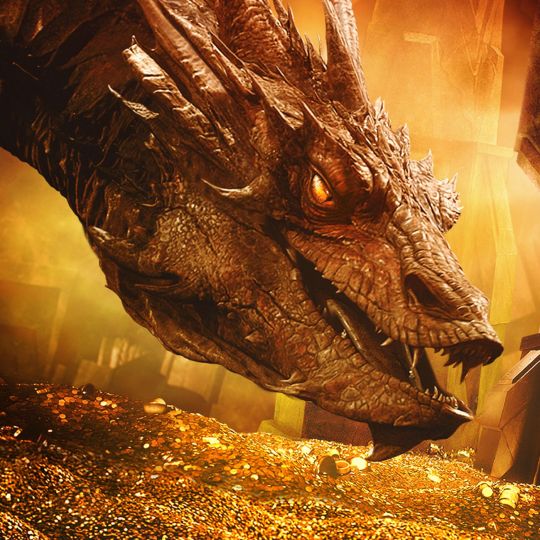
Dragons Redesigned by Reign of Fire: Example List
Now that we’ve gone over just a few of the talking points about Reign of Fire’s dragon designs (although I didn’t even get into the flat, spaded tail look in detail), here’s an undoubtedly incomplete list of several examples that have either entirely taken the design and/or were massively influenced by it...
(please note that not everything in this list held entirely to Reign of Fire’s design, obviously; some have the fire, some don’t; some have horns, some have head/brow ridges; but all of them are wyverns and most are darkly-colored)
Skyrim - Obvious influence with the general design, skin/scales and ridges design, as well as coloration; however, it is noteworthy that the Elder Scrolls has had dragons with no forelegs since at least 1998, in the game Redguard - though that dragon was also very brightly-colored (also of note: Peryite, while technically a Daedric prince and not a dragon, had four legs at least as far back as Daggerfall in 1996)
The Hobbit films, specifically The Desolation of Smaug onward - as mentioned before
Harry Potter movies - Wholesale. Two streams of fire from mouth flaps in Goblet of Fire, generally dull greyish and/or brownish colorations, no forelegs, short/simple horns that are mostly ridges...
Gods of Egypt - The giant fire-breathing cobras have the mouth flaps
Game of Thrones - This one’s pretty obvious too.
Disney’s Maleficent - In the new live action Disney movie(s), the dragon falls right into this design (though the fire doesn’t come from mouth flaps)
Netflix Witcher series - Villentretenmerth is very much a wyvern design and a dull shade, and he in fact has no horns at all, even though dragons weren’t portrayed this way in any previous Witcher adaptations
Stargate SG1 (season 10) - In the episode series “The Quest,” a dragon appears and... well, it looks just like all those other dragons, though the fire does come from its throat.
Beowulf (2008) - I try not to ever talk about or think about this film, but I have to just throw out there that the dragon is very much Reign of Fire, especially with that wyvern design.
Seventh Son - If you can call Malkin a dragon - she was called one, I think - she definitely also has the same kind of dull-colored wyvern design.
Sucker Punch (movie)
Lots and lots of B-movies and direct to DVD/streaming films - Dawn of the Dragonslayer, Dragon (2006), Dragon Crusaders...
Something to note, also, is that cartoons, anime, and other non-film media is mostly - but not entirely - free from this influence. Cartoons especially are free from it, partially because they aren’t influenced by Hollywood producers who want “serious” and “realistic” dragons. Cartoons are allowed to have magical, colorful, four-legged dragons. Unfortunately, we are deprived of those in live action film and television, by and large.
There are still other exceptions - most notably things that were created before this influence, like Dragonheart and its spinoffs and sequels, which have thankfully kept their dragon designs consistent instead of erasing their forelegs.
Of course, why dragons are depicted as four-legged and winged in the first place - and when this depiction arose - is another topic entirely. I’m not going into that right now, seeing as how this post is already preposterously long.
Long story short, I was rewatching the movie Gods of Egypt and, when I saw the giant cobra monsters breathe fire, I was possessed to write this article. Because Reign of Fire’s influence is something I have always noticed ever since its release, and something my brother and I talk about a lot (and everyone who knows me has surely heard me talk about it, too) - because, frankly, it’s always bothered me. My favorite dragons are traditional dragons: four legs, bright colors, wings, horns, breathing fire, the works.
So, although the original creator of these design ideas did something cool and different because he wanted to do his own take on dragons, Hollywood decided that these design cues should be taken to dumb down all dragons forever, the same way that Hollywood has dumbed down so many monster designs so that the only acceptable ones just a bunch of near-replicas of each other, including werewolves.
I think it’s very sad that film producers think you can’t take something like dragons or werewolves seriously unless they are dull, nontraditional, and ugly. And I say ugly in the sense of these are not pretty, majestic fantasy designs - they are, many of them, intended to be ugly. Though I personally also hold the opinion that most of them are ugly regardless of if they are intended to be ugly.
So - now you know! If you haven’t seen Reign of Fire, go check it out to meet the father of modern dragon designs, from the color of their hides to the shape of their bodies, the smaller horns, and - sometimes - even their tails.
(Special thanks to everyone on my discord who helped me compile this list, as well as of course my brother and all our ranting at/with each other on this topic over many years)
If you like this post, maybe you’ll enjoy the rest of my blog, where I post a lot about folklore and all kinds of monsters (especially werewolves)!
Werewolf Facts --- Patreon
#dragons#pop culture#dragon#reign of fire#creature design#folklore#wyvern#wyverns#game of thrones#skyrim#harry potter#the desolation of smaug#the hobbit#movies#film#hollywood#long post#EXTREMELY LONG post
73 notes
·
View notes
Text
History as an academic discipline is quite a bit more scientific than I think people on tumblr are really interested in giving it credit for. I don’t want to diagnose the root cause of the problem too much, but I do think it’s quite intimately related to the way in which lots of folk on here are driving by emotional politics rather than ideological politics — which is to say, people feel that something should be the case, and therefore believe X, Y, or Z, rather than people have a structural analysis of something, and therefore believe X, Y, or Z. This goes hand in hand with the rise of popular individualism in the anglo west in the late 70s, early 80s (see Emily Robinson et al.) and the various associates political/cultural elements therein. I won’t say more here, but this is a lot of what my research is on, So I do have thoughts.
Anyways — history is a far more scientific discipline than people are really ready to accept on here. When you go through training as a historian, you’re trained in a variety of methodologies and historiographical philosophies, and a lot of them sit in tension or contradiction with one another. However, even the most hardline subjectivists (like EH Carr, for example) would agree with this premise: historiographical narratives cannot be disproved on sentiment alone. They can only be disproved with sufficient research or reinterpretation of extant evidence. They cannot be disproved simply because they don’t feel right.
What that means — and this is an emotionally and politically complex reality of the field, please don’t assume that I’m endorsing it — is that as historians, we have to accept certain things as historical fact, even if we don’t necessarily agree with them morally or politically. For an example from my field, I think it’s incredibly gender essentialist and degrading to assert that ‘women tend to tell more emotive life histories and men tend to tell more event-oriented life histories.’ But the existing research says that this is true. In my research, I’ve worked to overturn this orthodoxy by uncovering new evidence of women who don’t tell emotive life histories and instead choose event-oriented narrative structures. I have also reinterpreted existing evidence to argue that the initial conclusions are wrong. However, given that my research has not yet stood up to peer review, nor has it been published, I have to accept that the state of historiographical play says that the above statement is true. I feel as if that’s wrong, but insofar as proving that it’s wrong goes, I haven’t met the criteria yet. I intend to, but I’m not there yet.
This is fine, this process doesn’t cause problems for trained historians, for archivists, museologists, etc. The problems arise when laypeople — particularly laypeople on social media — misinterpret how and why this process of knowledge production exists the way it does, and through that misinterpretation extrapolate information that they should not reasonably be extrapolating to draw illogical conclusions. To continue the example of my research, it would not be unsurprising to see people on tumblr call me a gender essentialist for accepting that historiographical premise in my work. It would not matter that politically I am not a gender essentialist, nor would it matter that my work seeks to problematise that gender essentialism, the very fact of my beginning with a widely-accepted (if politically and historically incorrect!) premise for my research would be enough to earn the GE label. You see this frequently with the generalisations that history as a discipline is homophobic, that historians are all colonisers, or that historical work is inherently misogynistic. The problem here is that it erases and complicates the work of historians who are trying to unsettle those norms — and the historians who are not homophobic, imperialist, or misogynistic and who are not working to unsettle those norms, but whose work nonetheless remains valid and important.
We, as historians, cannot problematise every bit of knowledge at all moments. The orthodoxy has to be chipped away bit by bit. I’m not going to say that it isn’t frustrating, tiring, or even (tbh) dehumanising, but it’s the state of the state in academia. But that we are forced to work within these incredibly tight parameters does not make us morally or politically illegitimate; if there is a way to secure a revolution in the academy that has not yet been tried, I would welcome advice on it. Such as it is, reform is the only plausible path forward (in the academy!!! Not generally!!!).
When people on tumblr, typically people who are not aware of how the historiographical process works, pontificate about historians writ large being homophobic/misogynistic/racist/whatever, they are actively damaging the historians who most need to be heard. The pale, male, and stale bourgeois academics aren’t hurt by those accusations, because they simply don’t give a fuck. Historians like me, however, queer, disabled, nb historians (for just one case), are hurt by those accusations. It functions as a delegitimisation of the research that I do, of the serious and credible political work I am undertaking both as a researcher and as an activist, and it encourages me to give up on this small corner of a wider struggle. If historians like me — or indeed historians not like me, but who do not fit the bourgeois academic mould — are chased out of the academy, you will not have succeeded in making history more accurate, more diverse, or more politically correct in its analyses. You will have, essentially, ceded the ground to the regressive orthodoxy. And for whatever criticisms I have of tumblr’s liberalism and general detachment from practical politics (go touch some fuckin’ grass guys!), I do not actually believe that you’re trying to undermine the effort to decolonise and democratise knowledge. I think a lot of you are being incredibly unhelpful and even very damaging, but I think it stems from ignorance, not malice.
Anyways, it’s really late, I’m very tired, I’ve had an incredibly difficult day dealing with people (historians! yes! bad women historians!) who promote rank misogyny in their obsession with emotive politics above serious politics, so I’ll do everyone a favour and stop talking and go to bed. But I do really wish people would approach this stuff with more sensitivity and respect than they do right now. Ugh. Okay. Night.
6 notes
·
View notes
Text
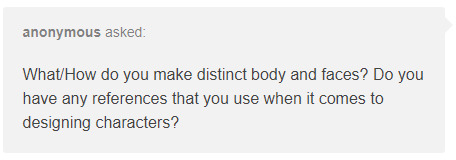
All right, there are quite a few things that come to mind with a question as broad as this, so here’s my best attempt to sum up what character design means to me in like 5 minutes :,D. I’m going to start with a few very quick sketches that talk about more my general approach to drawing, but I’m going to build up to how it all connects with character.

Step 1) Find reference! Whenever you can, use reference, it will always make your character’s posing look 100 times more genuine than anything you can pull from your brain, and that’s nothing to feel bad about. It’s not cheating because we’re not stopping at Step 2 either, which is where the misnomer comes in that you’re just ‘copying’ (protip: even step 2 isn’t a straight Copy; as long as you’re not tracing, you’re not copying, and even tracing has its uses for personal studies). I could do a whole answer of it’s own about picking your reference, but I’ll keep it short by saying: not every reference will fit every character. Keep in mind your character’s attitude when choosing your ref. Some poses are so generic they’re one size fits all, but even this very simple pose has unique character to it. The way the legs are posed, to me, gives it a young and girlish feeling, and depending how you played with the expression, you could even make it come off shy. An overbearingly confident character, while also taking an arms crossed pose, will likely position their legs differently, assuming a stance that takes up more space, etc.
Step 2) Draw pretty much exactly what you see first, but keep it simple. Think of the body like individual shapes; anatomy is not the focus right now, and you’ll actually hinder yourself if you hone in on that first. What you want to do at this stage is capture what the pose is generally doing; character isn’t involved yet
Step 3) Now, working off 2′s framework, start considering body type. If you skip the previous step, you might have a hard time capturing the gesture correctly, since it’s a lot for your brain to juggle at once. When I sketched these two different body types, I built it straight off the first drawing, erasing lines as needed.
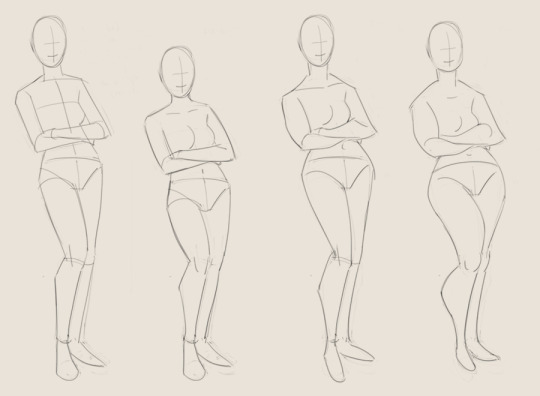
So the first image includes some extremely basic body type variations, this one pushes that idea further. 1 is the basic frame from the last image, while 2 is about playing with proportions. There are a lot of ways you can play with proportions, and as I’ll come to sound like a broken record about: make those decisions thoughtfully. For example, when I made this version shorter than the reference base, I had to consider exactly where I wanted her to lose that height. Here, I made her shorter waisted, took a little length from the legs, and gave her a squatter neck as well. You can do one of these or all of them. Just keep in mind those are all individual options. Letting your train of thought stop at ‘this character is short/tall so I’m just going to generally shrink/stretch their body’ means you’ll run out of variety pretty fast, and sometimes the overall proportions can end up looking wonky (though there’s always exceptions to the rule, remember that the individual body parts should remain correctly scaled in relation to each other).
Image 3 is another approach to proportional manipulation, except rather than focusing on height, it focuses on fat distribution and to a lesser extent bone structure. Again, there’s so many individual places you can focus on here, make sure to mix them up. Arm size, shoulder broadness, chest and hip size, leg thickness and musculature, foot and hand size and so forth.
Image 4 is a further exaggeration of image 3 and the lines have started to get a little more stylized. While image 3 is still reasonably realistic, 4 is just starting to cross into cartoon territory. Advantage of 4 is that when you are able to push the proportions further due to the leniency of style, you can sell a clearer idea and a clearer character. Downside is, well, it looks more cartoonish now, and depending on the needs of your image that might not be what you want ie: it can look like a mistake rather than a purposeful choice if everyone else around the character is drawn more realistically.
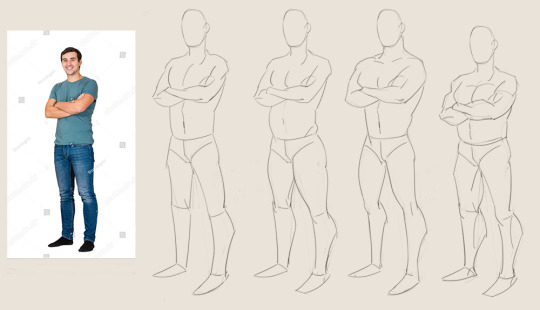
Also… I see variations on this general advice quite a lot for women, but don’t forget about doing the same for men. It’s great to see how eager a lot of artists are to experiment with the female form that is simply absent in a lot of mainstream media, but I find that men really tend to fall by the wayside here even though they often get equally shallow treatment in the mainstream. There’s usually like 2-3 ‘go-to’ body types for men and that’s it. Men’s bodies can have the exact same amount of variety as a woman’s, including the individual ways the fat can be distributed on it, and the assorted ways their proportions can be played with. Whenever I find an artist that does this it’s like striking gold to me tbh.
So there’s some very rough hows. But, perhaps even more importantly than any of that, is WHY you make these choices. This is going to get a little stream of consciousness, but with a question this broad, I tried to hit on as many general points I could think of in regard to my own process.
-When I start to design a character, I really need to have an understanding of them first. This includes things like backstory, personality, habits, so and so forth… Yes, all of this stuff shows up in their design, even if it’s just a drawing of them standing straight up. This isn’t just like ‘this character got this scar at age 7 so I need to know where it goes′, I mean in depth info about them. I touched on this a little bit earlier, bringing up the different ways a character would assume the same general pose, but let me expand on that.
-What do I mean by personality? So there’s the most obvious answer, which is that a bubbly character will assume bubbly poses, a sullen character will slouch more, etc… But let’s take it further than that. This is a concept I’ve touched on in past tutorials, but here’s a quick recap. A character’s personality involves their opinions, for one; how do you make that show up in their design? Well, one of the most obvious questions I always ask myself is: what is their opinion on their own appearance (the thing we are drawing)/how do they want to be perceived by others? Consider a strong character. I see a lot of artists who take this thought as far as: okay, this character is strong, so I’m gonna throw a 6 pack on him, maybe a nice pair of guns, and call it a day. Which leads to like, nice art, but also...kind of bland? I think that’s because this is a rather half-baked approach. How can we take it further? Ask yourself more specific questions. Is your strong character concerned with being perceived as an ‘ideal’ sort of fit by others (the type you give that showy 6 pack to) or does that not matter to them? (more likely to look ‘chubby’ if not outright fat, though probably is just as if not more capable of actually doing some real heavy lifting than saran wrapped abs man). If they’re some kind of mystical being that can look like whatever they want (ie: the anime waif that can also lift 1000 lbs-trope), you should still take into account their personal perspective on appearance. Don’t just stop at ‘this guy/girl is strong so they’ll look super shredded’ or ‘they’re magic so I’ll do whatever’. Doing this, you’ve instantly lost a chance to inform the audience more about the individual there beyond ‘they’re strong’
-Break it down further with their habits. What is their daily life like? If they’re running ten miles every day they should probably have some strong looking legs. If their job involves a lot of lifting, maybe focus on the upper body more and leave the legs less defined. Do they eat a lot? Or drink? The way the fat distributes in both these cases will be noticeably different (and this isn’t even taking into account points like an endomorph vs an ectomorphs body, which I always suggest reading up on). I’d definitely recommend drawing as many different body types as you can just as studies, in order to add these variations to your mental library. I’m sure every artist has seen this popular athlete line up by now, but really study images like this. Don’t just mindlessly copy what you see when you create your own characters though; think about why those athletes have the bodies they have, what they specifically did to get them like that, and how that can apply to your character’s own life.
-One thing that has always bothered me is how often artists are afraid to use the head (not the features; I’ll get to that in a second) as an extension of the body when it comes to imbuing it with variety and character. While it is absolutely possible to have a thin face and a fat body (as is any combo), it’s another missed opportunity not to experiment with chubby cheeks, a soft jawline, etc. It’s a cliche to mention him at this point as an inspiration, but one of my very favorite things about Mucha’s art was how he was able to make fuller faces look so beautiful despite being a rather nontraditional approach (so many art books try to tell you this is a big NO). example, example. These faces actually look like real individuals to me than a drawing that focuses too hard on being generically aesthetically pleasing.
-So, facial features. A face with less traditional features isn’t just going to be more memorable than Stock Beautiful Face #73, but it’s basically a more zoomed in version of informing the audience about the character in the same way the body does.
-Know tropes, play with tropes, do not rely on tropes. Sunken bone structure, long features-guy will always pretty much read like a villain (or at least someone off-putting), but find somewhere to make the formula your own. Give him thicker eyebrows or big ears. Give the girl with the standard doll-face a nose that sticks out a little more prominently or a crooked smile.
-Speaking of are so many different ways to draw a smile, do not underestimate the mileage you can get out of this one feature alone. Artists tend to have a favorite way to draw smiles, in my experience, but remember your character. Would they have a big toothy grin, a handsome ‘cool’ looking smile, a small shy lopsided one, ones that touch the eyes, ones that don’t… This is probably a repetitive point by now but just do whatever you can not to draw the exact same feature on two different characters, and make sure to think through your reasoning for every choice you make. To me, it’s always immediately evident if an artist really knows their character or if they’re just trying to make something aesthetically pleasing. The former is always more attention grabbing in my opinion.
-One of my favorite things to consider when designing a character who’s part of a family: genetics and how you can play with them to inform the audience more about the character’s story. Does this character take after their mother or father? How? Why? Why why, you might ask? This isn’t a photo of a real person, this is an illustration that you should be making deliberate choices about every step along the way. It’s one thing to draw a character that looks like their parent simply because logic dictates they should, another to make meaningful decisions as to where and why they do. Some examples: He has his father’s eyes because they carry the same intensity and other characters are a little put off by him because it (conversely, maybe he’s such a gentle character that this detail stands out twice as strongly). He has the same hair as his father, but he styles it differently to avoid the association. She has her mother’s nose which everyone compliments her on so shes happy to be seen in profile. She has her father’s broad shoulders and she’s a little self conscious about it so she tends to wear baggier clothing. Etc etc! In all these cases, you can communicate these details through even a simple drawing of the character standing alone, and should try to as often as you can.
-In the end, the only way you’re going to know how to draw all these different details, whether they be different body types or different facial features, is by studying real people. Draw as many different kinds as you can, add them to your mental library. Your reference will never give you everything you need to work it, and I’m not sure if that’s maybe what this question as getting at-- if I have a reference folder of go-to ‘types’ or something. I don’t. I have a folder of poses labeled with characters I think they’d fit, and that’s about it. If you’re just imitating what you see in a photo, you’ll always be drawing That Person, not Your Character. So you are going to have to pull some of it out of your brain. Note, however, the important difference between just ‘making it up’ and recalling information you’ve studied in the past.
That said, while on this last topic of expanding your mental library, that includes not just doing studies, but also learning and observing the ways other accomplished artists work. Here are some of my book recommendations when it comes to those which have most helped me in regard to this particular subject. This includes books that specifically tell you how to vary your body types, but also ones that just have a lot of examples of different kinds:
Morpho: Anatomy for Artists
Morpho: Fat and Skin Folds
Famous Artists School Course in Illustration and Design (If anyone is interested in this one and has trouble finding a non $500 copy, hit me up and I’ll help you out)
Spirit of the Pose
Anatomy Lessons from the Great Masters
Drawing People: How to Portray the Clothed Figure
Figures from Life (my favorite currently; not the most varied array of figures but he goes in depth on how to successfully grow an academic study of a model into an illustration influenced by your own ideas and personal style)
If you found this answer helpful, although it isn’t specifically about character design, I go a little more in depth about some of the topics I briefly covered here (such as choosing the right reference, good vs bad reference in general, honing in on shapes, pushing the pose, etc) in this short book of mine :>
#tumblr messed up the coding on the original ask so I had to repost this!#art tutorial#hope this helps!!#not sure if got a little too rambly#i wonder if it's hashtag justintpthings to spend 3/4ths of a post talking about how to draw by talking about thinking lol
115 notes
·
View notes
Text
Hi Good Omens fans, ever since making this blog, and trawling through the archives for old art, I have been thinking again about trends from before the TV-show, and the way people draw Aziraphale and Crowley. I wanted to make this post addressing it but this is not “discourse” or to start a fight, in fact I would be perfectly content if all I did was make people think critically about what I am about to say and not even interact with this post at all, but I feel like I need to say it.
Talking about any racist undertones to the way people draw our two favorite boys usually makes people dig their heels in pretty fast. This is not a callout post for any artist in particular, this is not me trying to be overly critical of artists especially since they have more talent and skill than I do, and I’m going to address some common counterpoints that I frankly find unsatisfactory. Let’s just take a moment to set aside our defensiveness and think objectively about these trends. It took me a while to unlearn my dismissive attitude about these concerns so maybe I can help others get over that hurdle a little faster. Now let’s begin.
I’ve been kicking around the Good Omens fandom since maybe 2015 and for art based in book canon, whether it was made before the TV show came out, or because the artist is consciously drawing different, original designs, I’m going to estimate that a decent 75% of all fanart looks like this

Aziraphale is white and blonde and blue-eyed while Crowley is the typical “racially ambiguous” brown skin tone it’s become so popular to draw podcast characters as nowadays.
And the question is why? With the obvious answer being “it’s racist,” but let’s delve a little deeper than that.
A common thing I hear is that people get appearance headcanons fixed in their mind because the coverart of the book pictures the characters a certain way. My first point is this only shifts the question to why the illustrators drew them that way, when there aren’t many physical descriptions in the book. My second point is that while there definitely are cover arts that picture Aziraphale as cherubic, blonde, and white and Crowley as swarthy, dark-skinned, and racially ambiguous...
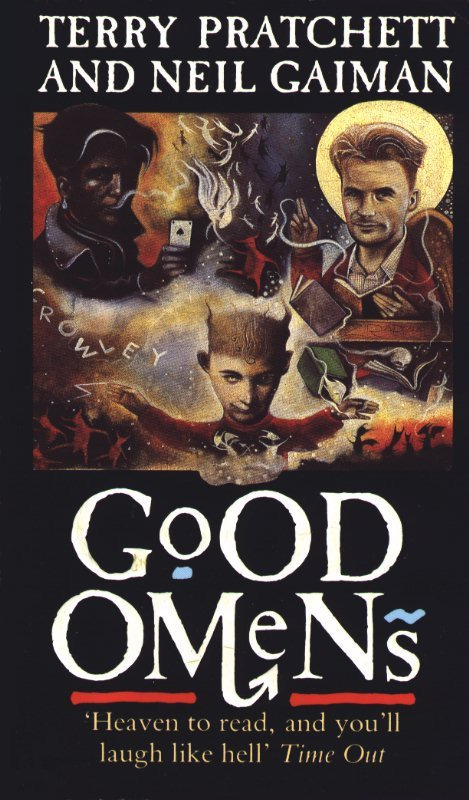
(side note: why is Crowley’s hand so tiny? what the hell is going on in this cover?)
It’s much more common for the covers to simplified, stylized, and without any particular unambiguous skin tones
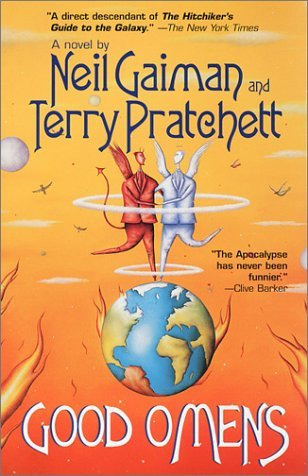
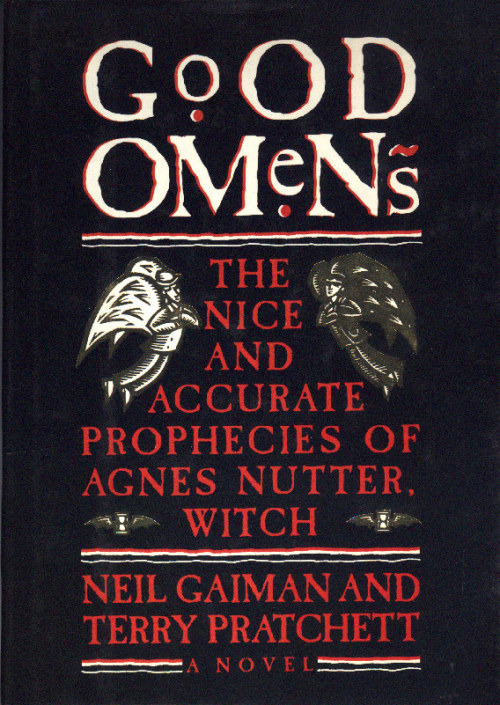
I don’t know about the UK but the most popular version in the United States is the dual black and white matching covers
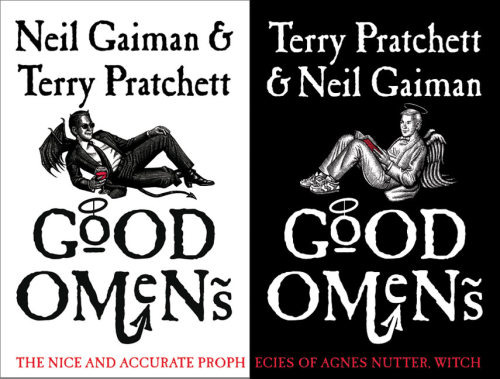
And while you could make an argument that the shading on Crowley’s face could suggest a darker skintone, it seems obvious to me that lacking any color these are not supposed to suggest any particular race for either of these two, and the contrasting colors are a stylistic choice to emphasize how they are on opposite sides. If anything, to me it suggests they are both white.
In short I simply do not buy the argument that people are drawing Aziraphale and Crowley this way because that’s how they were represented on the cover art of the book. If you draw them the way they are on the cover then whatever, I don’t care, but I don’t believe that’s what’s driving this trend.
The second thing people will say is that Good Omens is a work of satire, and it’s based in Christian mythology which has this trend of depicting angels as white, and it is embodying the trope of a “white, cherubic angel” paired with a dark-skinned demon for the explicit purpose of subverting the trope of “white angel is good, dark demon is bad” since Aziraphale is not an unambiguous hero and Crowley is not a villain. “It’s not actually like that because Crowley isn’t a bad demon, and Aziraphale isn’t actually a perfect angel” is the argument. This has a certain logic to it and allows some nuance to the topic, but to this I say:
Uncritically reproducing a trope, even in the context of a satire novel, is not enough to subvert it. Good Omens is not criticising the racist history of the church, and while the book does have some pointed jabs at white British culture (such as Madam Tracy conning gullible Brits with an unbelievably ignorant stereotype of a Native American) it is not being critical of the conception of angels as white and blonde or the literal demonization of non-white people. That’s just not what the book is about. So making the angel white and the demon dark-skinned, playing directly into harmful tropes and stereotypes, is not somehow subversive or counter-cultural when doing so doesn’t say anything about anything.


Please consider fully the ramifications of the conception of white and blonde people as innocent and cherubic and dark-skinned people as infernal and mischievous, especially in modern contexts...
Black people are more likely to be viewed as violent, angry, and dangerous. Priming with a dark-skinned face makes people more likely to mistake a tool for a gun. Black people are viewed as experiencing pain less intensely by medical professionals. Black men are viewed as physically larger and more imposing than they actually are. The subconscious racial bias favoring light skin is so ingrained it’s measurable by objective scientific studies, on top of the anecdotal evidence of things like news stories choosing flattering, “cherubic” pictures of white and blond criminals while using unflattering mugshots for non-white offenders.
This is why I say that if you’re going to invoke the “whites are angelic” trope, you better have a damn good subversion of it to justify it, because this idea causes real harm to real people in the real world. And Aziraphale being a bit of a bastard despite being an angel, I just don’t see that as sufficient. I am especially cautious of when it’s my fellow white fans that make this argument, not because I believe they do this out of any sort of malice or hatred of people with dark skin, but because I know first-hand it stems from a dismissiveness rooted in not wanting to think about it for too long because it makes us uncomfortable. Non-white people do not have the luxury of not thinking about it, because it’s part of their life.
Now the strongest textual evidence people use, in the absence of much real descriptor, is this:
"Many people, meeting Aziraphale for the first time, formed three impressions: that he was English, that he was intelligent, and that he was gayer than a tree full of monkeys on nitrous oxide. Two of these were wrong; Heaven is not in England, whatever certain poets may have thought, and angels are sexless unless they really want to make an effort"

This piece of art has circulated in the fandom for so long I don’t know the original artist and it’s been used for everything from fancovers to perfume. This is where I found it and it’s one of the first things that come up when you google this quote about Aziraphale.
Doesn’t it just feel like this is the man that’s describing, some blonde effeminate gay man? Well guess what, there’s the “blonde as innocence” trope rearing its ugly head again, because the stereotype of gay men and effeminacy as being a white and blonde thing is--ding ding ding you guessed it--racism. And why would intelligent suggest a white and blonde person, except if the stereotype of a dark-skinned person is less intelligent?
Now the point of “people assume Aziraphale is British” is another sticking point people will often use, claiming that the stereotype of a British person is white and blonde. I guess this has some merit, since the British empire was one of the biggest forces behind white colonial expansion, and it seems disingenuous to assign “British” as “nonwhite” as soon as we’re being satirical, in the same way I found it distasteful that the TV show made God female when so many of the criticisms of the church are about its misogyny and lose their teeth as soon as God is no longer male.
However consider that 1.4 million Indian people live in the UK. I heard a man say aloud once that the concept of a black person having a British accent was a little funny, as though Doctor Who doesn’t exist and have black people on it. And I’m not overly familiar with the social landscape of the UK, but I understand they’re experiencing a xenophobia boom and non-white Brits aren’t considered “really British.” The stereotype of non-white people not being British only exists because of reinforcement in media. If you really want to be subversive, drawing Aziraphale as Indian goes way further than drawing him as white IMO.
Now let’s talk about Crowley. He is almost always drawn with a darker skin tone than Aziraphale, even when they are both white, and while I’ve outlined above how this is problematic on terms of linking light skin with innocence, I think it does have an extra layer. I think it also has to do with the exotification and fetishization of brown skin and non-white people.
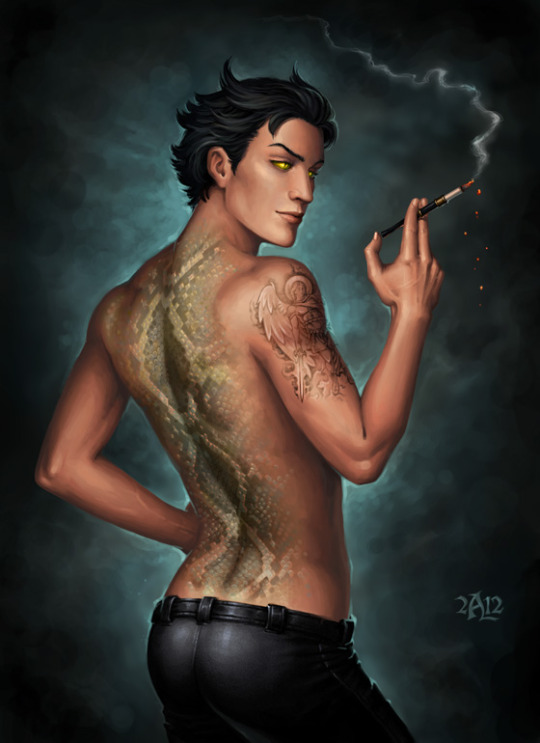
This artist’s tumblr is gone now but their art is still on dA and while it’s definitely beautiful and well-done, I think this is a very good example of what I’m talking about.
Crowley and Aziraphale necessarily contrast each other, so describing Aziraphale as “British” might suggest that Crowley is “foreign-looking.” I also know *ahem* that the fandom generally thirsts over Crowley to hell and back, so making him a swarthy, tall dark and handsome is not necessarily surprising.
An interesting thing happened when the TV show came out, and everyone started drawing Michael Sheen!Aziraphale and David Tennant!Crowley more and more often: It’s not ubiquitous, but it does happen that sometimes artists will draw David Tennant’s skin darker than it actually is. The subconscious urge to see Crowley with dark skin is for some reason that strong for many people. And I really encourage people doing this to think about why. Not naming any names but I’ve working with fanartists before for collabs who I had to ask to lighten “bad guy” demon’s skin tones because it looked like they were making the skin darker on purpose to make them look scarier. This person is a perfectly pleasant person who tries not to be racist! And we both still fell into it accidentally, and it took me a while to notice and point it out, because the ingrained stigmatization of darker skin is pervasive yet often goes unnoticed.
What is the solution? I don’t know, and as a white person I’m not really qualified to make that call. Do we draw them both with the exact same skin tone? Is it better to make them both white? Should we make both of them non-white? Should we only make Aziraphale non-white? I am consciously aware of the fact that the Good Omens fandom is mostly white people, so most of the art we make is being both made by and consumed by white people, so I don’t feel comfortable saying “draw these characters of color specifically” because that can also veer into fetishization territory very quickly. This is not specific to good omens but I think we should pay attention to what fans of color say in all fandom spaces and weigh our choices even if they seem insignificant. And it’s important to realize that fans of color will not be a monolith in their opinion either, and it’s our responsibility to recognize that everyone can be affected by racism and social issues differently, the same way all women are affected by misogyny differently so just because one woman says such as such is misogynistic and another says it’s not. I’m sure there are non-white fans who think it’s perfectly fine to draw Aziraphale as white and Crowley as ambiguously non-white. I’m not saying they’re wrong. And I’m not saying you can’t reblog this kind of art, or that people who make or made it should feel bad about themselves. But so often this sort of thing goes unaddressed just because people don’t like thinking about it, and well, avoiding hard questions never really goes well I think.
193 notes
·
View notes
Note
i wanted to ask about your post with kunoichi? what do you mean about a baby boom? i think that is giving the text some excuse regarding treatment of kunoichi. the writing was not very fair.
post in question
oh i absolutely agree the writing was not fair, and has considerably dated naruto as far as being a consumable media now vs first release. it was a product of the late 90s, after all. and especially when you consider the apparent working conditions of mangaka, plus the influence of character popularity on development and publisher intervention, it’s no wonder it just didn’t seem to... have an even playing field. as i said in that post too, the series has always kind of been very tell not show, especially when it comes to reassuring readers that sakura, for instance, is incredibly strong and talented, but we don’t actually get to see it.
but in regards to a baby boom: we’re told (again), that during the third shinobi world war, konoha threw children barely out of the academy at trained shinobi. they were literally just putting bodies on the battlefield to have numbers. i mean, the war was not a good move on konoha’s behalf, as hiruzen stepped down after claims of being weak for not seeking reparations, orochimaru felt betrayed about being passed over for hokage, fugaku and the uchiha clan efforts were ultimately ignored inciting their plans to overthrow konoha, itachi was heavily traumatised, sasori left suna shortly after, ao stole the byakugan from a hyuga clan member, kakashi rose to prominence after receiving the sharingan, and well. jiraiya’s best efforts to help a fledgling akatsuki do some good turned sour after hanzo’s intervention.
more down below ⬇️
so like. how the hell did konoha still manage to have shinobi after, because we’re told (again) that the death toll was so high, i think it was this particular war that even ended with the average lifespan being drastically lowered to around 30 due to the sheer number of child deaths, plus post war trauma. and then following this war the year after, the nine tails was unleashed on konoha. they didn’t really catch much of a break between all of this. (also, take a shot every time konoha is absolutely totalled?)
and too, the idea ultimately that a lot of clans exist around preservation and survival, especially of their own jutsu. i kind of get for the sake of constantly drawing chapters a day, the families do appear small/one child to two parents, and any sort of branches are vaguely referenced to, but i kind of figure that the more prominent clans we’re introduced to would have more members. like the nara clan especially would have dozens of members. they have a whole forest to themselves, are heavily involved in politics of the shinobi government, as well as the medical side of things in konoha (they own a book detailing cures to any drawbacks from jutsu, such as the akimichi clan). shikamaru may be the clan head, but i would figure there are many other clan members.
which is why i kind of wondered about succession rights. it’s kind of implied i guess, or my takeaway was, that there was no real prominent ‘heir survival’ during the war. anyone who was able to fight, did. so either entire branches were shaved off clans, which you can also use as a basis of example of why there is only one present representative for the clans in naruto’s generation, it was more of a duty to continue the clan name that lead to some children being born, maybe there were succession fights following, or there was just a ‘well you survived so you earn the title’. kind of interesting too when comparing to the hyuga clan, who you would assume tightly regulated the byakugan (especially after hinata’s attempted kidnapping, and losing it to ao during the third war). in the hinted family scenes, they do seem to have a lot of family members. so either those are the remainders, since there is a generational gap (assumed via art lol) between neji and other side branch family members.
and like again, with the uchihas, not everyone was able to develop the sharingan. once someone did, their immediate family relations seemed to move up in prominence in the household. it is likely different again for bloodline based jutsu and release, yknow?
so in regards to kunoichi specifically, it wouldn’t surprise me if during naruto’s generation, how despite all these outward threats, they just wanted to kick off another baby boom in a few years time once they were all graduated and chuunin/jonin. especially when you factor in like, the last of the uchihas (assumed, at that time), and even if konoha’s older population had personal issues with them, they still valued kekkei genkai especially. and again, factor in one child per family, and how hiden jutsu are mostly passed on orally, they obviously want to keep their clan jutsu to themselves but to still have future generations...
i guess this also interlinks with the once existent concept of civilian government and the shinobi government. it kind of fades in and out, and we’re only really reminded of the daimyo and their power/influence when necessary, like during the chuunin exam arc, where they state the final showcase battles are to just prove that shinobi are worthwhile investments. gaara hiden also mentions how he specifically is seeking reparations for a post-fourth war, after defending the land of wind, and how the civilian government isn’t being generous. i know the movies aren’t all canon, but even like in the land of snow, they had such a small shinobi population that they ultimately had a civilian guided focus on technology development. so by boosting their population of potential shinobi, it would understandably mean they would also continue to have a reason to exist in the hidden villages. so encouraging rather traditional ways of attracting potential marriages... way to get that population boost kickstarted early.
even though it seemed that most of the shinobi we see who married just needed to get their asses handed to them by their future wives a couple of times lmao.
3 notes
·
View notes
Text
BIONICLE 2: Legends of Metru Nui is Still as Beloved as Fans Remember: A Response to Comic Book Resource and Matthew Attanasio
Hey everyone! I’m James, the guy behind Wall of History. I know I rarely drop the facade of my brand on official Wall of History accounts, but today, I’d like to make a more casual, opinionated post on something that’s been getting a lot of attention from the BIONICLE community on Twitter.
Last night, Comic Book Resources posted an article titled “BIONICLE 2: Legends of Metru Nui is Still as Pointless as Fans Remember,” and if you have even a surface-level familiarity with the BIONICLE community, I’m sure you can guess the reaction we had — CBR’s tweet was pretty quickly ratioed by fans, drawing comments like, “Comic book resource [sic] once again proving you do not require a brain to type,” and, “We think that the Vahki would like to have a word with you guys." BIONICLE fans generally agree that Legends of Metru Nui is the best film in the franchise, so claims that we universally “remember” it in such a negative light are completely baseless — I’d like to move past the inflammatory title, however, and analyze the actual contents of the article.
LEGO's decision to focus on prequel material was received as a slap in the face. While fans were ready to see the story press forward, it instead fell backwards to tell stories that held little significance to the ‘present day’ plot of the franchise.
To say that the story of Metru Nui held “little significance” to the plot of the franchise is ridiculous. For three years, fans had been given only vague legends about the origins of the Matoran and their struggle with the Makuta, and after Makuta’s defeat, “pressing forward” meant returning to the world they had left behind following the Great Cataclysm. To introduce us to that world and show us how the Matoran came to be in their present situation was an obvious next step for the story.
That's not to say the various comics and novels didn't deliver interesting stories; they did.
That’s true, they did! However, the rest of this article gives me reason to believe you didn’t actually read them (or, at the very least, didn’t pay attention when you did).
They just weren't what fans craved at the time. Legends of Metru Nui failed to bring anything valuable to the table in this regard, with a sloppy story, terrible pacing and forgettable characters.
There are numerous claims and implications throughout this article (we’ve already glossed over one) that BIONICLE fans generally felt certain ways about this film, as well as this story arc as a whole, but none of these claims are backed up. To blatantly misrepresent the feelings of the community like this is rather poor journalism.
Regarding your claim that Legends of Metru Nui failed to bring anything valuable to the table, I’ll reiterate my point from above — the ending of Mask of Light saw the Matoran take the first steps toward reclaiming their home, a home that had been hidden from us, the fans, since the inception of the franchise. Showing us why and how this home was lost in the first place proved to be a vital step in expanding the scope of the BIONICLE legend. Makuta’s actions in Legends of Metru Nui ended up being the inciting incident for the rest of the story, a story that was largely set in the Matoran Universe introduced by this arc.
Your claim that the film has forgettable characters is, like your claim that fans generally remember this film negatively, demonstrably false. Vakama is widely regarded as one of the best characters, if not the best character, in the franchise (the last post on this very blog is evidence of this), and Nidhiki proved to be so popular that his origin story was later relayed to us twice, in the short story “Birth of a Dark Hunter” and the novel BIONICLE Legends #4: Legacy of Evil.
These new heroes are Vakama, Nokama, Matau, Onewa, Whenua and Nuju, Toa of Fire, Water, Air, Stone, Earth and Ice, respectively. Whereas Mask of Light's Toa Nuva were already fan-favorites, the Toa Metru were a mixed bag, and this film did nothing to help their image. In truth, all three of the main Bionicle films failed to highlight how awesome the Toa could be, which is a shame.
BIONICLE is not the story of the Toa. It’s the story of the Matoran.
In the behind the scenes featurette on the Legends of Metru Nui DVD, the narrator makes the odd claim that both Mask of Light and Legends of Metru Nui are “all about the Toa.” This claim is odd not just because Mask of Light literally isn’t about the Toa (it’s mostly about two Matoran), but also because the Matoran have always been the heart of the franchise — a fact that Legends of Metru Nui comments on.
Many fans feel that Mata Nui: The Online Game is the best BIONICLE media, and it’s a story that largely focuses on the Matoran. You play as a Matoran, you primarily interact with Matoran, you solve Matoran problems… and until the very end, the Toa are mostly off doing their own thing. This makes for a really compelling story, precisely because the Matoran aren’t “awesome” like the Toa. It’s cool when the Toa unite their elemental powers to make the Makuta explode into a pile of scrap metal, but it’s compelling when the Matoran armies, whose leaders previously seemed preoccupied with their own problems, unite to save the ragtag Chronicler’s Company from what would have been a deadly Rahi attack.
The Matoran have always been the emotional heart of the BIONICLE legend (the Toa’s stories do focus on saving them, after all), and Legends of Metru Nui understands this. When Lhikan tells Vakama to “save the heart of Metru Nui,” the Toa Metru immediately assume he’s talking about himself… and that kind of makes sense! Lhikan is, after all, the last Toa, a fearless, noble hero, and the last bastion of light in a city being consumed by shadows. Of course he’s the heart of Metru Nui! The Toa Metru spend most of the film searching for Lhikan, but when they find him, he’s not the hero he used to be anymore — he’s a small, frail Turaga now, and he berates Vakama for seeking out him instead of saving the true heart of Metru Nui, the Matoran. This is a great twist, not only because it finally delivers on some of the spooky foreshadowing from earlier in the film, but also because it sends a clear message to the audience that the Matoran are the heart of this legend.
The plot revolves around Vakama's (voiced by Alessandro Juliani) inner struggle to realize who he is. If that sounds familiar, it's because that was basically the plot of the first Bionicle film, which handled these themes in a much stronger way.
While it’s true that Takua and Vakama both struggle to accept their destinies as Toa, I feel Vakama’s struggle is the stronger of the two, as his is based in the very relatable anxiety of impostor syndrome.
That's largely because Vakama, along with just about every other character in the film, is incredibly boring.
This is one of the comments I mentioned above that makes it hard for me to believe you actually read the comics and novels that tell the rest of the Metru Nui story. Vakama’s character arc is undoubtedly the most complex in the franchise, based in relatable anxieties, and actually has a clear beginning, middle, and end (contrast this with the more repetitive character arcs of the Toa Nuva, who have to learn about the importance of unity several times over before they finally internalize it).
Despite being the protagonist, Vakama has an incredibly erratic and unfocused arc, while Whenua (voiced by Paul Dobson) and Nuju (voiced by Trevor Devall) receive next to no development at all.
This latter statement regarding Whenua and Nuju is true, but I don’t think it works as a criticism of the film, which is clearly meant to focus on Vakama, Lhikan, the Matoran, and the Makuta. Rarely does a film with an ensemble cast give a complete arc to every single character, and if it keeps the film more focused, that’s a good thing.
And whereas the antagonistic Makuta had a consistent, threatening presence in Mask of Light, he's an absolute joke here.
He eats people in this movie!
However, much like Mask of Light, Legends of Metru Nui maintains the problem of poor editing to the point of being laughably bad. There are transitions and cuts that make absolutely no sense. The movie struggles to let scenes settle and develop, with many in the middle lasting no longer than a minute, which is extremely jarring to watch.
Alright, I’ll give you this one — the editing could stand to be a bit more polished. It’s a film that’s trying to juggle quite a few plot threads, though, so I think its ambition makes its editing shortcomings forgivable.
For example, in the comics, writer Greg Farshtey explains why Vakama experiences visions of the future. But in the film, there's no explanation for this at all, making it seem like Vakama has clairvoyant powers out of nowhere (not that his vision [sic] do anything substantial in the film).
This is an extremely odd comment, because it’s just not true on either count. Vakama’s visions are never explained in the comics, but they are explained in the film, barely fifteen minutes in: “Visions can be a sign of madness, yes, or messages from the Great Spirit.”
The claim that Vakama’s visions contribute nothing substantial to the film is also objectively false, since his visions are what compels the team to go after the Great Disks, from which Vakama crafts the Mask of Time.
There are plenty of other small lines and instances that ignore the continuity, like Whenua commenting on how he went from being a Matoran archivist to a Toa fugitive in a day. That's obviously not how it works -- the disk hunt alone takes a while in both the comics and the film, so Whenua's statement makes no sense.
Whenua’s line is, “When I woke up, all I worried about was cataloging.” He does not explicitly claim to have been a Matoran when he woke up. All this line does is show that Whenua thought he’d be able to return to his life as an archivist now that the Morbuzakh and Krahka had both been defeated.
Of course, nowadays, many Bionicle lore scribes have properly allotted the film in the larger Bionicle timeline. But at the time of release, it felt like Legends of Metru Nui was blatantly going against everything that was already happening in the canon, which was upsetting and/or painful to watch.
Do you have a source confirming that fans felt this way at the time? As I briefly discussed earlier, this article is filled with implications that BIONICLE fans in general feel the same way about Legends of Metru Nui that you do (this is even made explicit in the title), but none of these implications are backed up, and this is simply not the case.
For the true fans out there, revisit this film if you want. Just don't expect anything special.
I watched it just the other day and had a great time! And the last time I hosted a stream of it, we all had a great time! And this brings me back to the core issue with this article: the baseless claim, in both the title and contents, that BIONICLE fans generally dislike Legends of Metru Nui. Perhaps it’s odd to write a response like this for what’s probably a pretty harmless article. Perhaps it’s an overreaction. But to see a huge site like CBR publish an article like this, that's not just full of factual inaccuracies, but also misrepresents the feelings of most of this community, is upsetting. To ascribe this kind of negativity to a generally friendly community, a community that so genuinely loves what we love, flaws and all, for some clickbait ad revenue… is upsetting.
11 notes
·
View notes
Text
Who We Don’t See On TV
In 2018 and 2019, there were a total of twenty-six recurring transgender characters who appeared on television, including streaming services. About one in six Americans report that they personally know at least one transgender person ("Where We Are On TV"). More than ninety percent of American households watch television on a regular basis (Leavitt 41). What this means is that for five out of six Americans, the only trans people they ever see—and this is assuming there are any—are a handful of characters on TV. If you live in America, and pay any attention, you know that vitriol directed the way of the trans community is pervasive—and it's not so hard to imagine feeling the same way if your only experience of trans people comes from Fox News and Ace fucking Ventura. That's just one example—but media in general presents a skewed perspective of just about every minority group, with one obvious exception.
Cultivation theory provides a psychological model for how media alters our perception of the world around us. The information we take in and the stories we're told change the way we contextualize what we see, reshaping or reinforcing the framework on which we hang our experiences ("Cultivation Theory"). If you see a Muslim committing an act of terror on television—and then see the same thing happen again and again—you'll begin to draw a connection between the two ideas. That's an obvious and simplified example, but there are innumerable subtler ways in which media builds connections between concepts that gradually become part of our own perception of the world. It's worth examining what connections exactly are being drawn, who's drawing them, and how exactly they're changing the world we live in.
Essentially every demographic—with, of course, the exception of one very special minority group—is drastically underrepresented in entertainment media. There are many subtle issues with the state of diversity in entertainment, but this isn't one of them—it's a simple fact that our math is just off. The selection of people who are represented in media differs significantly from the actual population—the world of entertainment is not like ours. A study of 900 films released from 2007-2016 found that 31% of speaking roles were female—a demographic which famously constitutes almost exactly half of the population (Smith 6). This is as clear-cut as it gets—I fail to imagine what a reasonable explanation for this inequity could sound like. Other statistics featured in the report are the total 1.1% of movie characters who were LGBT (far fewer than exist in reality) and the 2.7% who were depicted as disabled (the real-life statistic is closer to 1 in 4), among others (Smith 8, CDC). The simple fact of underrepresentation is far from the extent of the problem; there's also the issue of the quality of that representation, which is overwhelmingly inadequate.
While a great diversity of characterization exists among ingroup characters—just about every white man that can be written, has—minority characters tend to be constructed from a limited bank of stereotypes. Characters from the least-represented demographics suffer the most from this oversimplification. Indigenous Americans, for instance, are very seldom seen on-screen, and when they are, they're depicted most often not as modern people but as 18th and 19th century stereotypes (Leavitt 40). The less we see of a group of people, the flatter and less realized those few glimpses are. It's clear that the majority-white population of writers who rely on other media for cues on how to represent marginalized groups, in the absence of diverse characterizations, are falling back on decades- or centuries-old stereotypes to tell their stories, and in that way, ill representation begets ill representation. That brings us to the problem of artists. A hefty majority of the people producing mainstream art are, not surprisingly, the same kind of people we see in front of the camera—white fellas. In the timespan covered by the Annenberg study, women made up 4% of film directors, while 6% were Black—and directors of other ethnicities were sequestered to an even more vanishingly small niche. The common factor is that every aspect of the entertainment industry is full to bursting with white guys, despite them being a comparatively small portion of the population.
The big question is: why is this an issue? And the answer is obvious and intuitive but nonetheless it's going to take a few pages to answer here.
In 2017, the most popular dream career among children in the US was to be a doctor. In 2019, two years later, more children aspired to be internet personalities than any other profession (Taylor). Children now feel that they are living in a world where "Youtuber" is a viable and fulfilling career. Which is to say that the landscape of media children were consuming palpably altered their worldview—they're identifying themselves with the people that entertain them, wishing to model their own lives after theirs. Media doesn't just entertain us—it is, in part, a substance with which we construct our self-image and our expectations of the world around us. This is especially true of young people, and when young people are presented with entertainment that belittles, stereotypes, or simply omits them, it can inflict real damage. It's been demonstrated that exposure to television is associated with lower self-esteem in all children with the exception of white boys—striking evidence of both the reality and real negative outcomes of inadequate representation. The messaging may not always be clear to us, but it gets through to children: you are not the type of person that we value.
One group that is constantly and severely devalued in this way is indigenous Americans. Contemporary depictions are so infrequent and negative as to subject them to what is known as "relative invisibility"—an almost total absence of any realistic or aspirational representations in culture (Leavitt 41). The effect of this pattern of representation is far from negligible. A study of indigenous American students found that greater exposure to media with indigenous American characters actually led to increased negative feelings about themselves, their place in the community, and their future aspirations (Leavitt 44). It's apparent from this result that a greater quantity of representation is not, on its own, an inherent positive. Exposure to a narrow and largely negative range of portrayals of oneself can narrow and negativize one's worldview and self-image. It's easy to imagine how one's dreams for the future could begin to feel futile if the only professions media seems to think you're suited for are mystical wise man and noble savage. Quantity of representation is not enough—in fact, if the quality of representation is lacking, greater saturation can actually do more harm than good, causing real harm to marginalized people whose self-identity and mental health may be damaged by poor portrayals.
When films and shows with stereotypical representations of indigenous Americans are released, indigenous Americans aren't the only ones watching. The same is true of Black people, Muslims, queer people, and every other heavily stereotyped community. While self-esteem is a real issue, we must also be concerned with the esteem in which others hold us. Prejudice presents a serious threat to many—prejudice informed in part by the media that we constantly consume.
There are real-life political consequences of entertainment. Evidence indicates a relationship between audiences viewing negative portrayals of Black people and negative opinions about policies related to affirmative action, policing, and other race-related legal issues, as well as a general tendency to hold unfavorable beliefs regarding Black intelligence, work ethic, and criminality (Mastro). This is deeply relevant as policy regarding the legal treatment of Black people is one of the most significant issues in the public consciousness, especially in the last few years. The concept of Black people as innately criminal, reinforced by stereotypical media portrayals, has been and continues to inform the debate around issues such as police violence and reform. Voters watch movies and television—so do congresspeople—and the way certain communities look in movies and television contributes to policy decisions that will save or end lives.
The Latin American community deals with similar portrayals in media—they are most often shown as inarticulate, unintelligent, unskilled laborers or criminals (Mastro). These portrayals, too, are highly relevant to American politics. The 2016 presidential campaign of Donald Trump relied heavily on leveraging negative stereotypes about Latin American and specifically Mexican immigrants—they were characterized as violent, predatory, and a threat to the American way of life. Those stereotypes, however, were not invented for the purpose of promoting Donald Trump as a presidential candidate—their utility as a political tool came from the fact that this was already a popular way of viewing Mexican immigrants. The widespread stereotypes about Latin American people are reinforced and reiterated by our entertainment, and in this case, formed the foundation of a winning presidential campaign.
There are good examples, too—in the 1990s and 2000s, American support for gay marriage rocketed from around 20% to nearly 60%, an incredibly rapid change in public opinion caused largely by advocacy in the media (Baume). Gay marriage was then nationally legalized in 2015. The way people are portrayed in our entertainment has serious real-world consequences, good and bad; human lives depend on how the most vulnerable people in our society are shown to the rest of us.
The solution isn't just more. That's part of it, but as we know, increasing the quantity of representation can be harmful rather than helpful if that representation isn't also high-quality. There is some correlation between the two—a greater number of portrayals of a group generally means more divergence from stereotypes—but there's a more fundamental issue at play. There are an abundance of stories that involve characters from marginalized groups, and yet the overwhelming majority of people producing stories in the mainstream are the same white men. As a culture, we enjoy stories about different types of people, but seem to be very comfortable allowing those stories to be told to us by an extremely homogenous group of writers and directors. The entertainment industry often even seems uncomfortable allowing minority actors to play minority roles; although casting white actors to play people of color has mostly fallen out of fashion, it's still commonplace to cast non-disabled and non-queer actors to play disabled and queer characters. This isn't necessarily an unacceptable practice in itself, but it's common enough to create a sense that queer and disabled actors are being actively excluded from entertainment. Of the limited number of disabled characters who appear on-screen, only 5% are played by disabled actors (Pearson). Actors such as Adam Pearson, who was never considered for the leading role in a film about Joseph Merrick (whose condition Pearson shares), are routinely passed up in favor of non-disabled actors (Pearson). Queer actors are similarly underrepresented. As one would expect, minority representation is vastly increased by the presence of minority directors and writers—movies by Black directors have six times as many Black speaking roles on average (Smith 3). The possibility of high-quality, equal representation is clearly tied to increasing diversity behind the camera.
But—what if straight white men just make better entertainment? Maybe they make up such a huge majority of the media industry because their work is simply more valuable. From a certain angle, this is sort of true. The value assigned to entertainment is, in part, determined by the critical response it receives, and media critics are mostly white men. In 2017, 78% of the top film critics were men, and 82% were white (Choueiti 2). It's not strange to enjoy media you see yourself represented in, and it's not surprising that the media we consume the most is mostly comprised of people who look like the people who we allow to determine its quality.
The entertainment industry as it stands today is a self-congratulatory stew of white men. Most representation of anyone outside that group is done on their terms, and as such, lacks both quantity and quality. The only way to break out of the narrow range of representations of marginalized people is to inundate the entertainment business with those people. We need women, queer people, people of color, and disabled people in the media, behind cameras and in front of them. The way these people are portrayed has real and severe consequences—for their mental health, physical safety, and place within our culture. Diversity in entertainment is not a frivolous issue. It matters, a lot, and it won't solve itself.
Works Cited
Baume, Matt. "Why Opinion Changed So Fast On Gay Marriage." Youtube, uploaded by Matt Baume, 25 June 2015.
"CDC: 1 in 4 US adults live with a disability." Centers for Disease Control and Prevention, 16 August 2018.
Choueiti, Marc et al. "Critic's Choice?: Gender and Race/Ethnicity of Film Reviewers Across 100 Top Films of 2017." Annenberg Foundation, USC Annenberg, June 2018.
"Cultivation Theory." Communication Theory, 2012.
Indiana University. "TV viewing can decrease self-esteem in children, except white boys." ScienceDaily, 30 May 2012.
Leavitt, Peter et al. "'Frozen in Time': The Impact of Native American Media Representations on Identity and Self-Understanding." Journal of Social Issues, 2015.
Mastro, Dana. "Race and Ethnicity in US Media Content and Effects." Oxford Research Encyclopedia of Communication, Oxford University Press. 26 September 2017.
Pearson, Adam et al. "'Actors don't black up, so why do they still crip up?' – video." The Guardian, 10 September 2018.
Smith, Stacy L., Choueiti, Marc. "Black Characters in Popular Film: Is the Key to Diversifying Cinematic Content held in the Hand of the Black Director?" USC Annenberg, 2011.
Smith, Stacy L. et al. "Inequality in 900 Popular Films: Examining Portrayals of Gender, Race/Ethnicity, LGBT, and Disability from 2007-2016." Annenberg Foundation, USC Annenberg, July 2017.
Taylor, Chloe. "Kids now dream of being professional YouTubers rather than astronauts, study finds." Make It, CNBC, 19 July 2019.
1 note
·
View note
Note
I hope this isn't too weird of a message to send, but doesn't it seem like Jonawagon doujinshi are pretty uncommon? I've only seen maybe 3 posted online & I have a copy of a SpeedJona doujin but aside from those I haven't come across any. Is it like a rare pairing or something? I thought they were fairly popular
It isn’t weird at all, anon! All the opposite actually, cause I love getting asks even if i'm not always around or it sometimes takes me a hot minute to get to them gfjhkjh
This is gonna be long and probs gonna have bits that might sound rant-ish to some, but I hope that’s alright! :'D
For starters, sadly, jonawagon/jonaspeed/speedjona or however you call the ship is quite an underrated ship. This has to do partly with the wrong perceptions some folks have built around it and around the characters as well (that them both and the couple itself are the epitome of "purity" and "innocence", sometimes even labelling them as "boring" as a result even though both characters are far from that, that "it could only be a one-sided thing" on Spw's end despite both showing and sharing a certain bond/closeness towards each other -closeness that sometimes Jonathan didn't show towards anyone else-, etc), partly because of the many timeskips in PB and all the scenes the anime cut out and people wrongly assuming that the main events happened in the span of a few days and thus people dropping the ball on the ship/characters when Jonathan and Speedwagon actually knew each other for as long -sometimes even longer- than other more popular characters/ships in jjba did, partly because neither Jonathan or Speedwagon are as popular as other characters in the franchise as a whole, and also partly because, as sad as it is to say this, the ship lacks a LOT of support, especially from it's own fanbase. While jonawagon is a popular and well liked ship overall (in the sense that even general fans who don't care much about shipping, or those who are still on the fence about mlm ships, or those who just don't actively ship jonawagon actually like and support the ship or the idea of it upon seeing the actual dynamics between the characters and their potential and the fact that the ship can actually coexist with jonaeri without altering the characters/making them ooc, nor altering the story and so on), it still lacks a lot of support from it's fans. I often see most other ships/characters get lots of reblogs and exposure from their fans on literally any and all platforms, helping those ships/characters reach new audiences and gaining more popularity and drawing interest from potential new fans, while jonawagon stuff as well as solo Jonathan or Speedwagon stuff usually only get likes and a few reblogs at most from their fans, which is nice and all, but it doesn't give the artists/writers any exposure nor get those works or the ship any farther than that and just keeps them within part of the already existing fanbase at best, which often times makes the artists/content creators lose interest in continuing to create stuff for the ship/characters. This is also why I always strongly ask -almost beg at this point ngl- for people to support the artists/writers/etc via reblogs!!
The ship having a bunch of different names also might have an impact on all of this, as it's not always as 'easy' to tag/find contents if you don't know how to tag/search for it. Jonawagon (normally used in the western parts of the fandom), JonaSpeed/SpeedJona (Western version of the ship's most popular names in Japanese: ジョナスピ/スピジョナ or JonaSupi/SupiJona respectively], SpeedStar (a name that became a bit more popular more recently after a mini jonawagon event in 2019), being the most common ones afaik, asides from the standard JonathanxSpeedwagon/SpeedwagonxJonathan ie and others. In short, Jonathan and Speedwagon as well as jonawagon are quite well liked and even popular to an extent, but they lack a massive amount of support from the fans, which also usually translates into artists and content creators for this ship losing interest in continuing to create new material for it and thus end up not making any more contents.
In regards to doujinshi more specifically, I’m a bit disconnected when it comes to Jojo doujinshi in general, but it seems to be a bit like that for most of the non "crazy popular" Jojo ships if you ask me, which is kinda normal considering the massive amount of characters in the whole series. Putting my experience as example, if it helps, I used to collect doujinshi from one of my previous fandoms, which had a shit ton of them for plenty of it’s ships and it was somewhat easy to acquire hard copies of despite it being an “old anime” basically while most Jojo doujinshi (especially anything that is not parts 3, 4 and 5) seems to be a bit hard to come across regardless of the ship(s) in them, even in auction sites or places like pixiv that sell digital copies if the author puts them up on sale, which is understandable since the aforementioned parts are some of the most popular parts in Japan, where most doujinshi is created, and thus take most of the fandom's interest -authors’ and readers’ alike-, as well as the hype for parts like Phantom Blood being long dead (with it being dead/dormant since the original airing of the anime ended in 2013, and it coming back ocassionally whenever there's a 'special' re-airing of PB in Japan or when events such as the Joestar Radio take place), so maybe my parameters on the whole subject are somewhat disproportionate?
This is also gonna sound all boomer-like, but I’ve also noticed, or it seems to me at least (still in comparison to the doujinshi from my previous fandom), that doujinshi books as we knew them aren’t /as/ common nowadays as they used to be a while back. Even the works themselves don’t seem to be much that way either. For example, doujinshi anthologies used to be a big thing a while back and, while they still exist, they don’t seem to be too common anymore (these worked as "promo books" of sorts for all the artists featured and they also helped lesser known/popular artists and ships to get some exposure to newer audiences). Nowadays such thing still exists, and I actually recall seeing a Jonaspeed/Speedjona anthology being made “recently” (recently as in 2019, if I’m not mistaken? it was published and sold during the mini Jonaspeed event they held at a Jojo con in Japan that year), but they aren’t nearly as common as they used to be, since now most artists can post any samples they want (much more reduced tho, cause you normally get a few pages instead of a full mini story) in places like Twitter or Pixiv. And it’s kinda the same with regular doujinshi. Before, most doujinkas had to publish a book in order to get their stuff out and get some exposure, so they were always working on new stories and making new books to sell and promoing their stuff, sometimes one after the other and even creating multi-volume stories in some cases. Now, thanks to how "easy" it is to get some exposure on social media, it’s much more common to see doujinkas for any ships/characters making short stories (1-4 pages, sometimes more) or just 1 page illustrations instead and posting them on their social media every now and then as a promo for their works. They also still make and sell their books (a few jonawagon artists on twitter do, at least), and these short stories/illustrations serve to boost their works instead, which is not a complain at all cause I think it's amazing tbqh! But this also translates into less stories/doujinshi being created as many of these artists often opt for leaving those stories that years ago would have been their own book or a mini story in a book as a prompt or a short story only.
As for actual jonawagon doujinshi, while it is not as common as say pt 3 doujinshi, there is quite a bunch of it. Some date from 2012-2013 (when the PB anime was originally aired), some are much older than that and some others are much more recent (as there are still some active jonawagon doujinkas around). There are also "fanfic books" that are also considered doujinshi and that seem to be a thing sometimes, but these contain little to no art at all and are usually written 100% in Japanese. The problem here is that not many of them have been scanlated/translated yet, sometimes because they aren't easy to find on sale online, sometimes because re-sellers who do have them set high prices for them plus shipping costs, sometimes because the artists/online shops won't sell stuff overseas, sometimes because those who do own doujinshi copies don't always know how to properly share them (since scanning a doujinshi in high or decent quality without destroying the book can be hard af) among other reasons.
All that said, there is a bunch of jonawagon doujinshi that has been scanned and is available online! but it can be tricky to get sometimes due to the different names this ship can go by and because of the "translations" of said names into different languages (as some doujinshi can only be found in Chinese sites, or Russian ones, and so on for example, so it can take some serious time to figure that out and have a successful search).
In all honesty, anon, I'm a dumdum and I had never thought about doing so in a more public manner until now, since I've already shared my entire jonawagon collection (pics, doujins, etc) with friends who have requested it more privately, but I can upload the doujins I have scans of if anyone's interested?? (I’d post the links where I found most of them but since my hd is pretty much dead and I can’t access Windows or my windows/mozilla profile, I’ve p much lost all my old bookmarks).
They were only like... 8 last time I checked (9/10 if you count the Japanese and English versions of the "Joestarsaaaaan" one), but it's something :D Just be aware that some of them are nsfw! and that a couple are either part of a book that has stories from other ships in them (I only have the jonawagon parts tho) or contain other ships implied or openly shown in the jonawagon story.
I also have about 4 more, but the scanlator of one of them openly requested for the file to not be reuploaded, so Idk if it'd be alright to share it? (and they also deactivated their blog, so there's no way to ask them for permission). The other 3 are scans a friend sent to me of their own doujinshi copies, so I also don't know if it would be okay for me to post them?? (i haven't seen this friend in over a year so idk gfhgjkjlkñ). 2 of those 3 are nsfw.
#long post#super long actually oof#sorry about that#i tried to make this shorter#i swear#orz#anonymous
3 notes
·
View notes